Welcome to REDi Island
Imagine a world where rivers, tides, and waves help power our communities, monitor our environment, and provide clean drinking water. Or better yet, explore that world through the Renewable Energy Discovery (REDi) Island web app!
Below you will find a text version of the interactive Renewable Energy Discovery Island app.
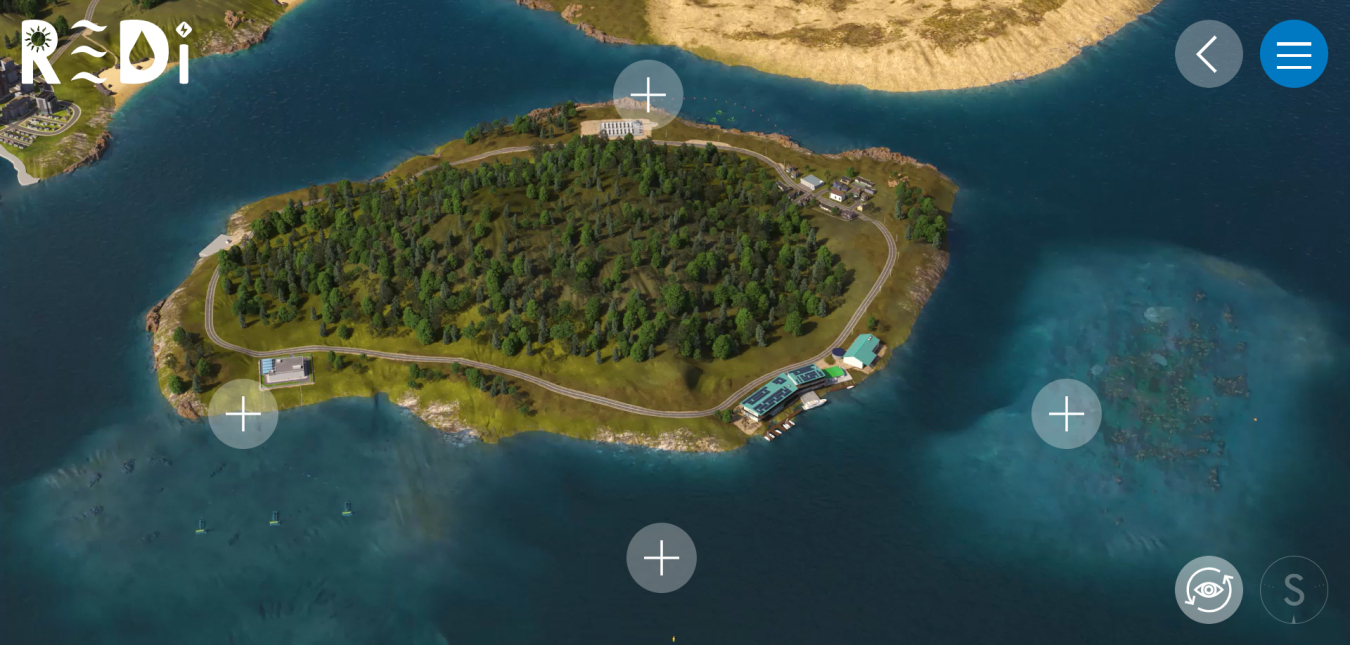
Tidal Town
Powers our community with predictable ocean energy
Tidal Energy
Learn how tidal energy uses the predictable and renewable movement of tides to produce electricity and why it can be crucial for power generation.
Learn More
Generated by the natural rise and fall of ocean tides and currents, tidal current energy is global and abundant, making it a valuable untapped source of renewable energy. This energy can be harnessed using either seabed-mounted or floating tidal current turbines. Tidal energy technologies can capture energy from currents in both oceans and rivers.
Additional Resources
- How Tidal Energy Works: TU Delft Animation
- The World's Most Powerful Tidal Turbine: Orbital 02
- NREL’s Robynne Murray Talks About Her Career in Tidal Energy
Battery Bank
See how battery banks support energy systems by storing excess power for consistent supply and promoting grid stability.
Learn More
Battery banks, or battery energy storage systems, enable energy produced by renewable sources, like the sun, wind, and water, to be stored and then released when the power is needed most. During low production they release stored energy, ensuring a consistent power supply and a stable grid.
Additional Resources
Navigation Channel
Learn about navigation channels, which are water routes designed to ensure efficient maritime transportation and prevent hazards for vessels.
Learn More
Renewable energy developers manage navigation channels through careful planning, considering vessel traffic patterns and safety measures to avoid conflicts.
Additional Resources
TIDAL TURBINES
Immerse yourself in tidal turbine technology!
Explore a 3D model of a tidal turbine:
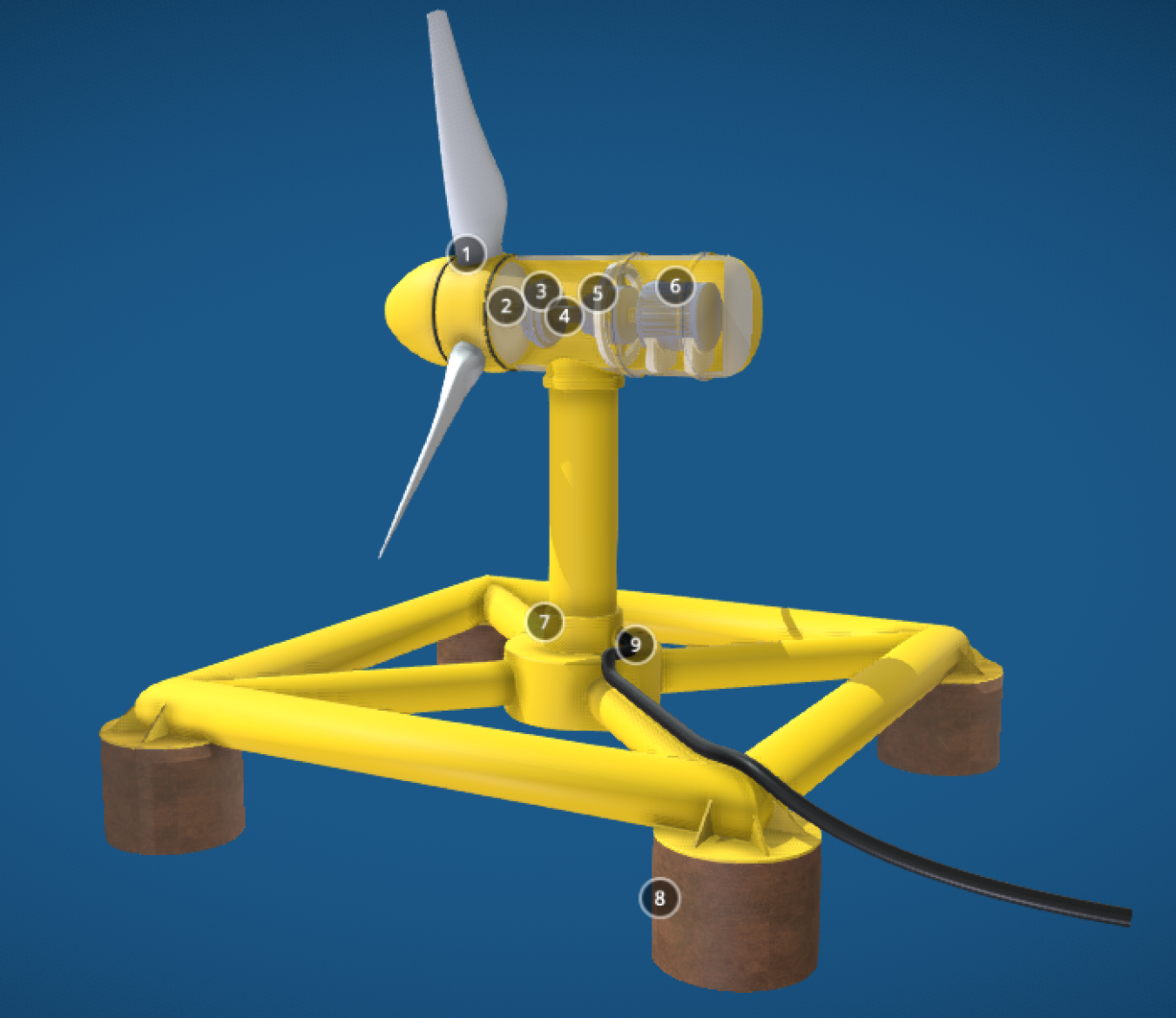
- Turbine Blades: As water passes the blades, a moment is created that rotates the rotor.
- Hub: Rigid piece that is connected to the three blades.
- Coupling: Connects the driveshaft at the interface between the rotor and gearbox.
- Driveshaft: Rigid shaft that connects the rotor to the drivetrain.
- Gearbox: Speeds up the rotational motion of the driveshaft.
- Generator: Converts the rotational motion of the driveshaft into useful electrical power.
- Support Frame: Supports the turbine so it can be placed at the optimal height in the water.
- Gravity Anchors: Heavy masses driven into the seabed to withstand the forces from tidal flows.
- Electrical Cable: Allows the electricity from the generator to be exported to shore.
Relative Device Size
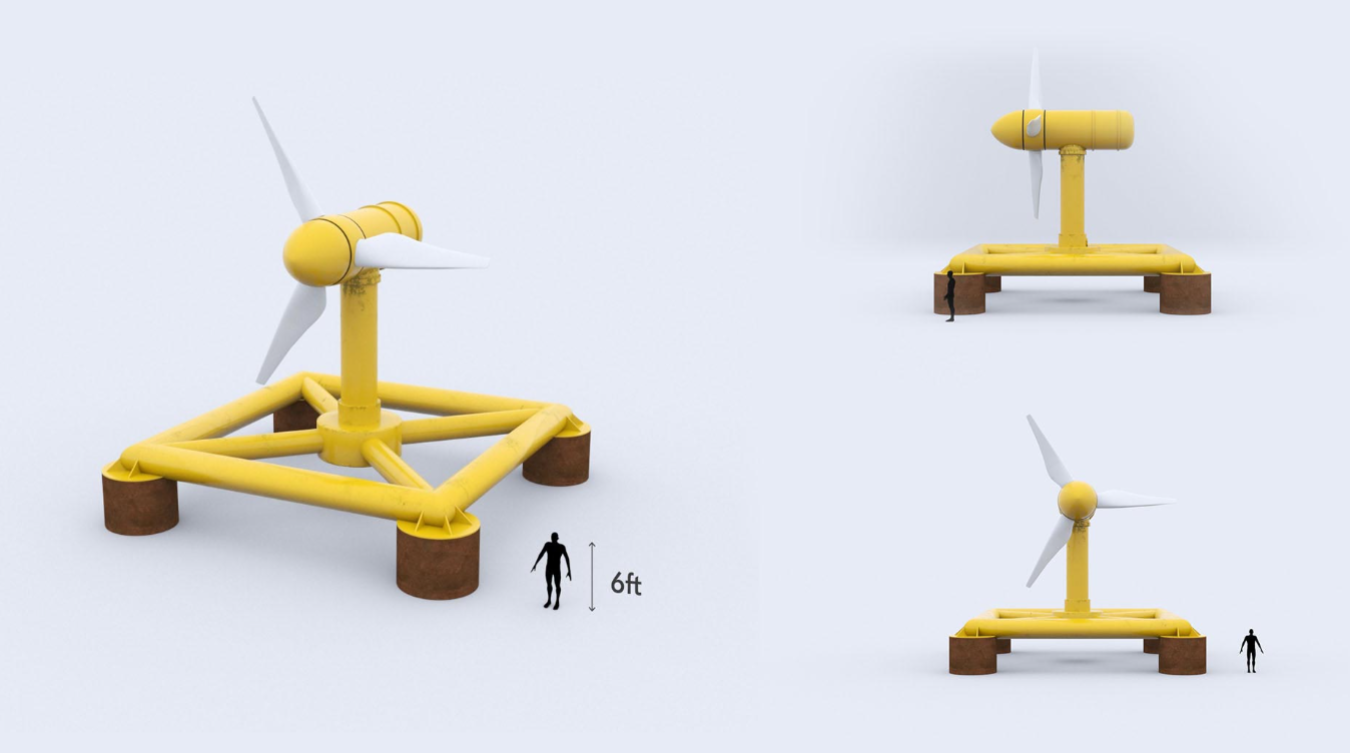
See how the size of a tidal turbine compares to a 6-foot-tall person.
Collision Risk
Learn why the study of collision risks is critical to safeguard marine life and ensure the sustainable development of marine energy sources.
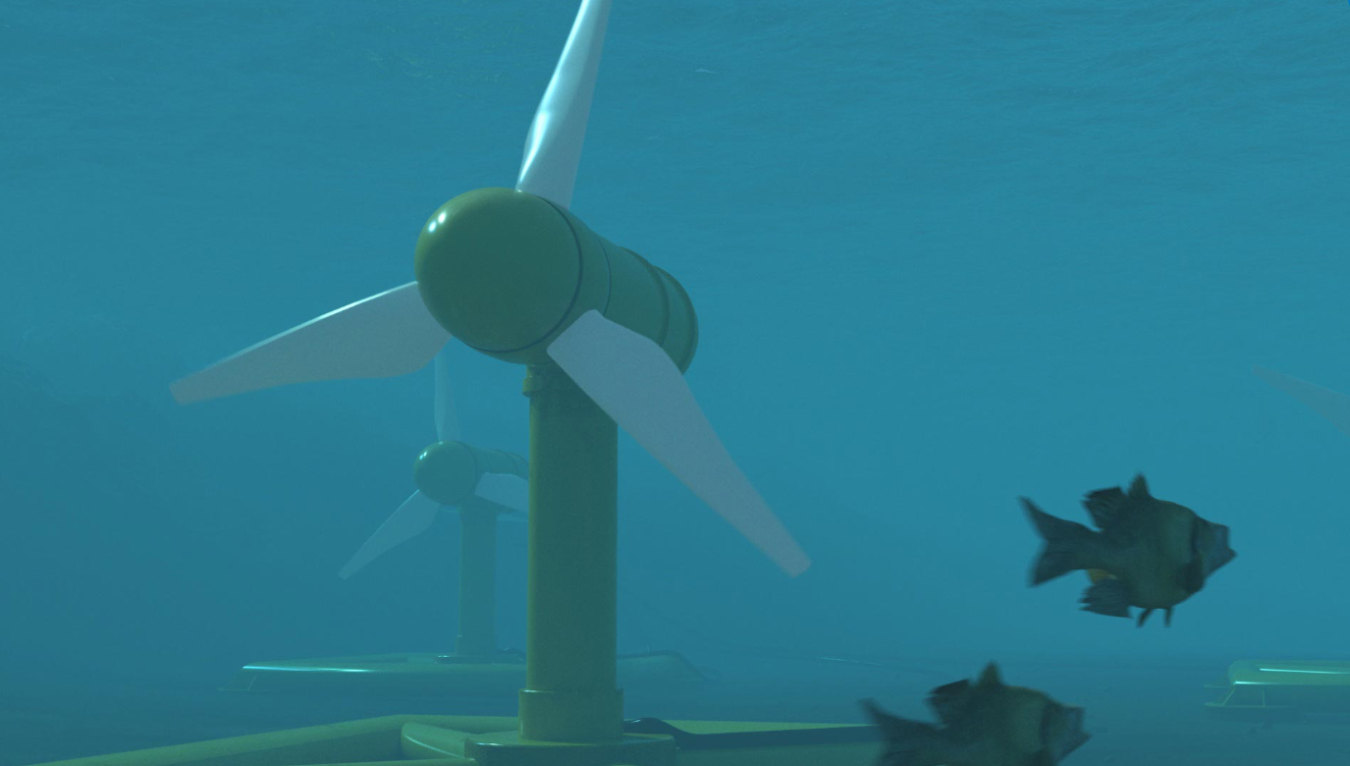
Learn More
While marine energy devices pose potential collision risks to marine life, observed incidents are rare. Monitoring, computer modeling, and testing are used to predict risks to marine life. Fish behavior studies indicate that fish actively avoid turbines, but ongoing research is important to evaluate and mitigate potential collisions as new device designs and deployment locations are explored in marine renewable energy development.
Additional Resources
Ocean Monitoring
Discover how technologies such as satellites, buoys, and sensors can track everything from sea surface temperatures to marine life migrations!
Learn More
Oceans cover 71% of the planet, but much of these watery worlds remain unexplored. From tracking tuna to tsunamis, ocean monitoring may play a vital role in safeguarding our environment and making informed decisions for our future by recording changes to marine life, pollution, and storms.
Additional Resources
- Learn About the Northeast Fisheries Science Center
- What Does it Take to be a Fisheries Observer?
- Tracking Tsunamis Through Ocean Monitoring
Observation Buoy
Learn what observation buoys are used for and how wave energy can provide the power they need.
Explore a 3D model of an observation buoy:
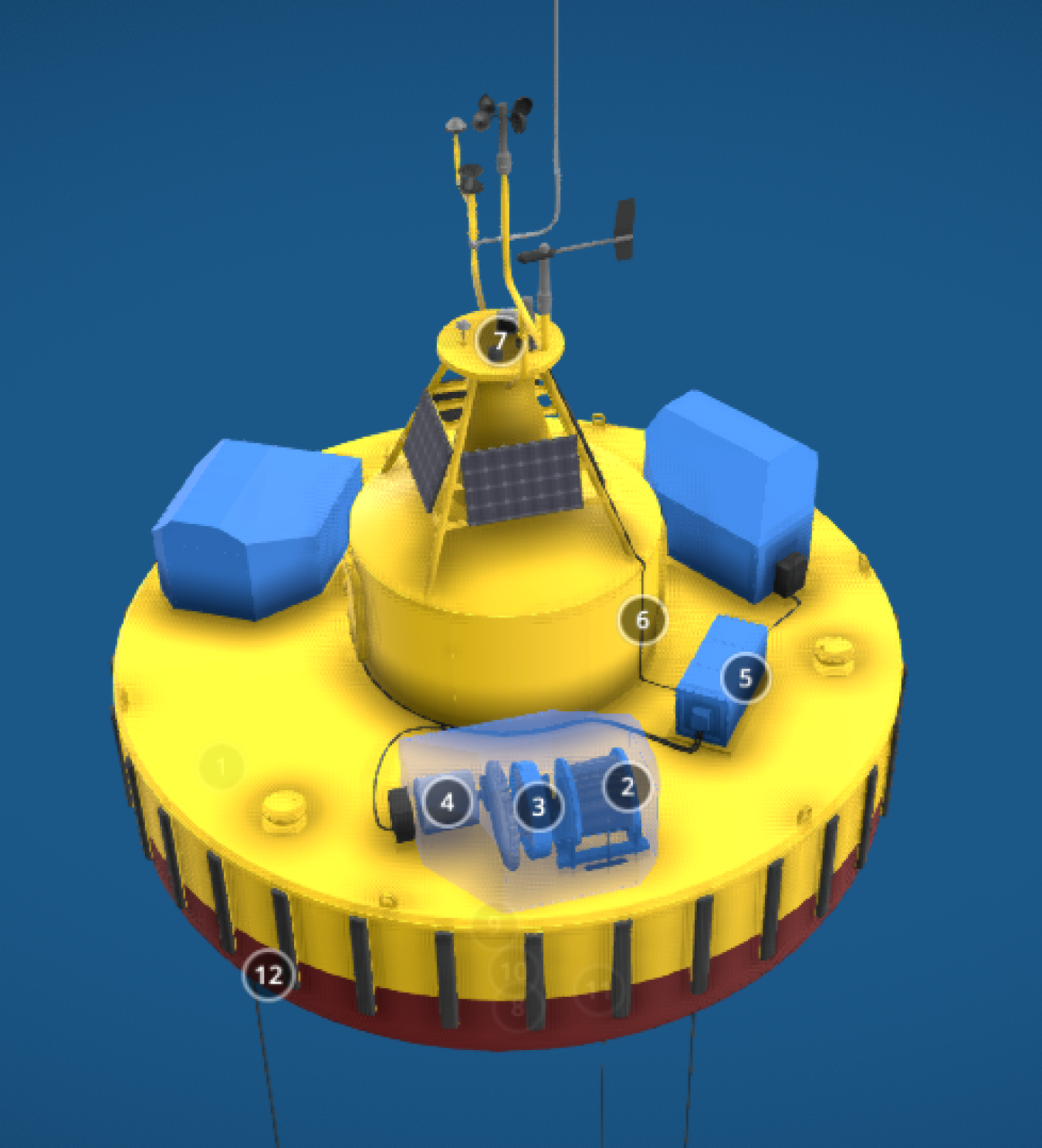
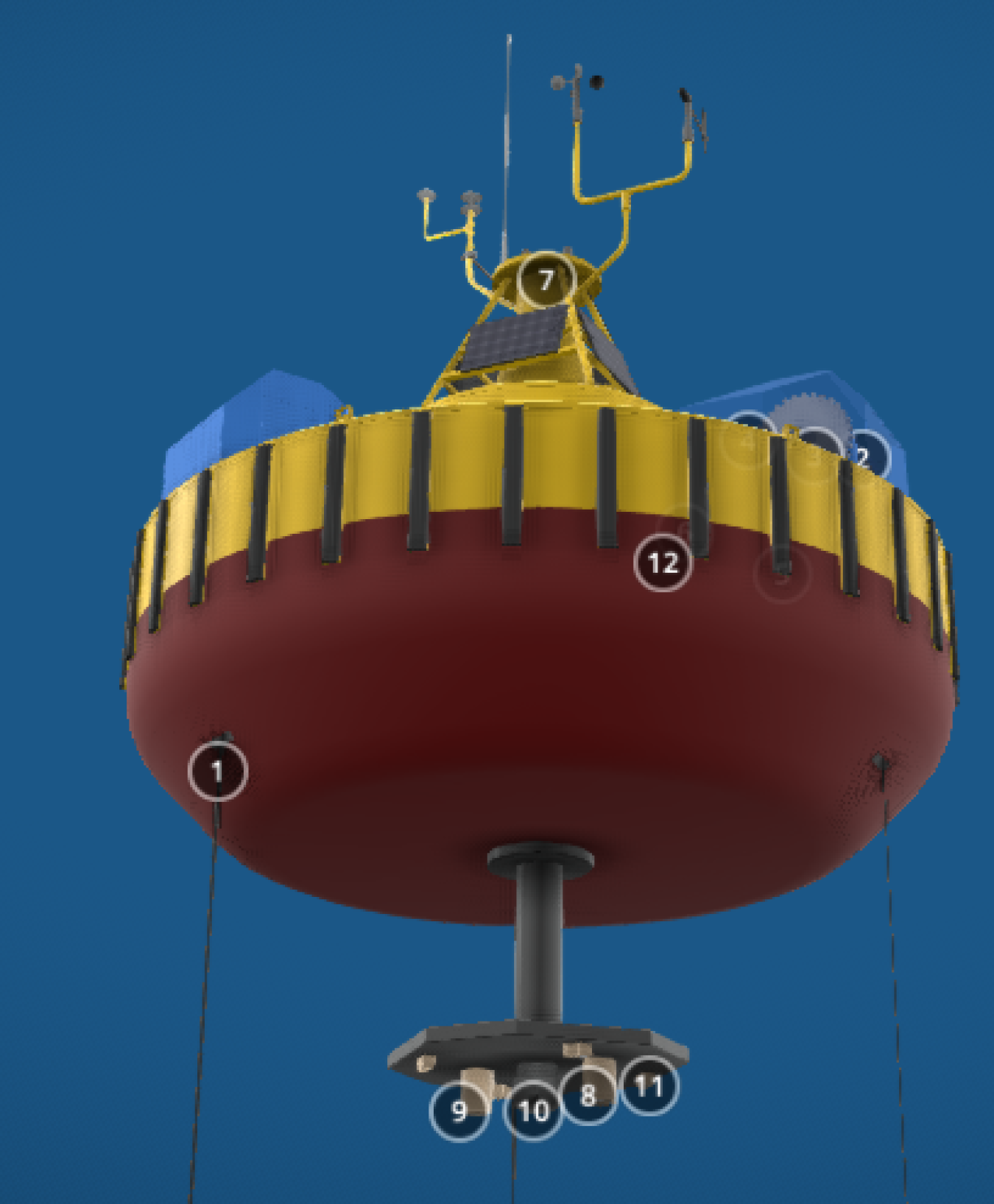
- Winch Cables / Mooring Lines: Connects the buoy to the seafloor to pull on the winch system as the buoy rises in the waves
- Winch Drum: Wraps the winch cable around the winch drum, causing rotational motion as the buoy moves
- Planetary Gears: Speeds up the winch drum rotation to spin the generator at a faster rate
- Generators: Converts the rotational motion into useful electrical power
- Battery: Onboard batteries store energy to power the various sensors on the buoy
- On-Deck Power Cables: Allows the electricity to flow to the battery and sensors
- Meteorological Sensors: Helps measure the local environment like humidity, temperature, and wind speed
- Downward-Facing Optical Camera: Records oceangoing life with light and enables greater scientific research
- Downward-Facing Acoustic Camera: Records oceangoing life with acoustics and enables greater scientific research
- Downward-Facing Transducers: Records audio from the water column
- Downward-Facing Strobe Lights: Illuminates the field of view for the downward-facing cameras
Learn More
Observation buoys are vital for monitoring environmental conditions in oceans and lakes. They provide real-time data on weather, sea levels, and climate, which can help with accurate forecasting and early warning systems for natural disasters. Information from observation buoys improves our understanding of ocean health and supports environmental management and conservation efforts.
Additional Resources
- The Wonder of Wave Gliders Animation by Mystic Aquarium
- 5 NOAA Buoys Aid Weather, Climate, Ocean Studies
- Meet BlueTech Robotics Engineer Adam Simko
Relative Buoy Size
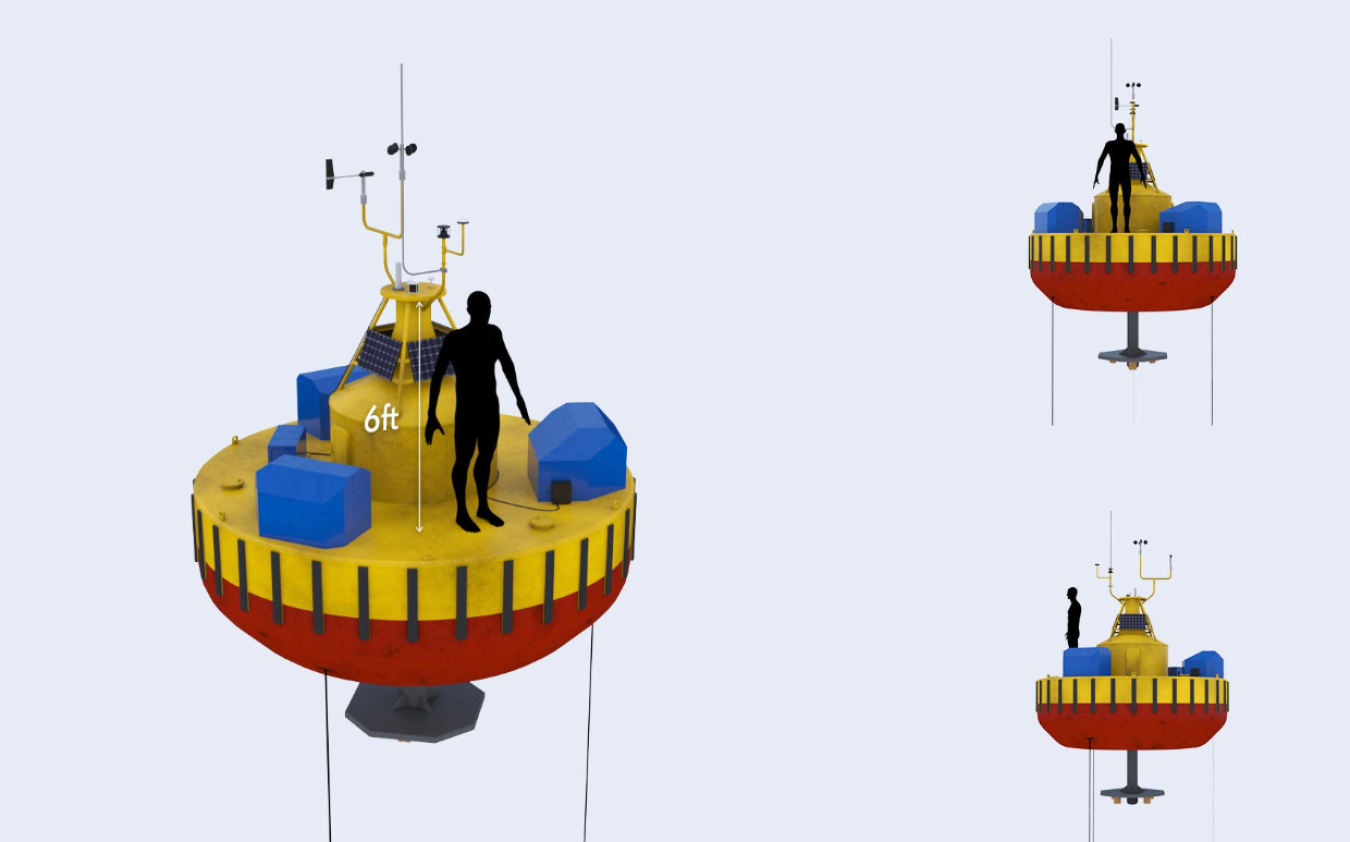
See how the size of an observation buoy compares to a 6-foot-tall person.
Underwater Sensors
Learn why underwater sensors are crucial for monitoring marine environments and how they provide real-time data vital for conservation efforts and research.
Learn More
Ocean sensing is pivotal for marine energy—it offers crucial data for site selection, resource assessment, and infrastructure design. Accurate information enhances efficiency and reliability of marine energy deployments. Ocean sensing technologies are used in geological surveys, navigation, communication, and marine environmental monitoring. Underwater sensors characterize seawater and the underwater environment by measuring water quality and monitoring contaminants. All these applications underscore the versatility and significance of underwater sensors in advancing marine science and technology.
Additional Resources
- How do Wave Buoys Measure Waves Around our Coastline?
- EPA’s Reactive Fish Sculpture Turns Water Quality Data Into Art
Coral Reef
Visit REDi Island's coral reef to learn about one of Earth's most biodiverse ecosystems.
Learn More
Coral reefs are crucial for marine biodiversity: They support a quarter of all marine species, provide food for millions of people, and offer coastal protection from storms.
Various technologies, such as underwater sensors and monitoring systems, are used independently to assess coral reef conditions. These monitoring tools measure parameters like water temperature, acidity, and biodiversity to gauge reef health. Marine energy devices have the potential to provide power to such technologies.
Additional Resources
Navigation Network
Warns nearby vessels of maritime hazards.
Watch the Navigation Network video.
Navigation Buoy
Understand how navigation buoys prevent vessels from approaching coastal reefs, shipwrecks, and other nautical hazards.
Explore a 3D model of a navigation buoy:
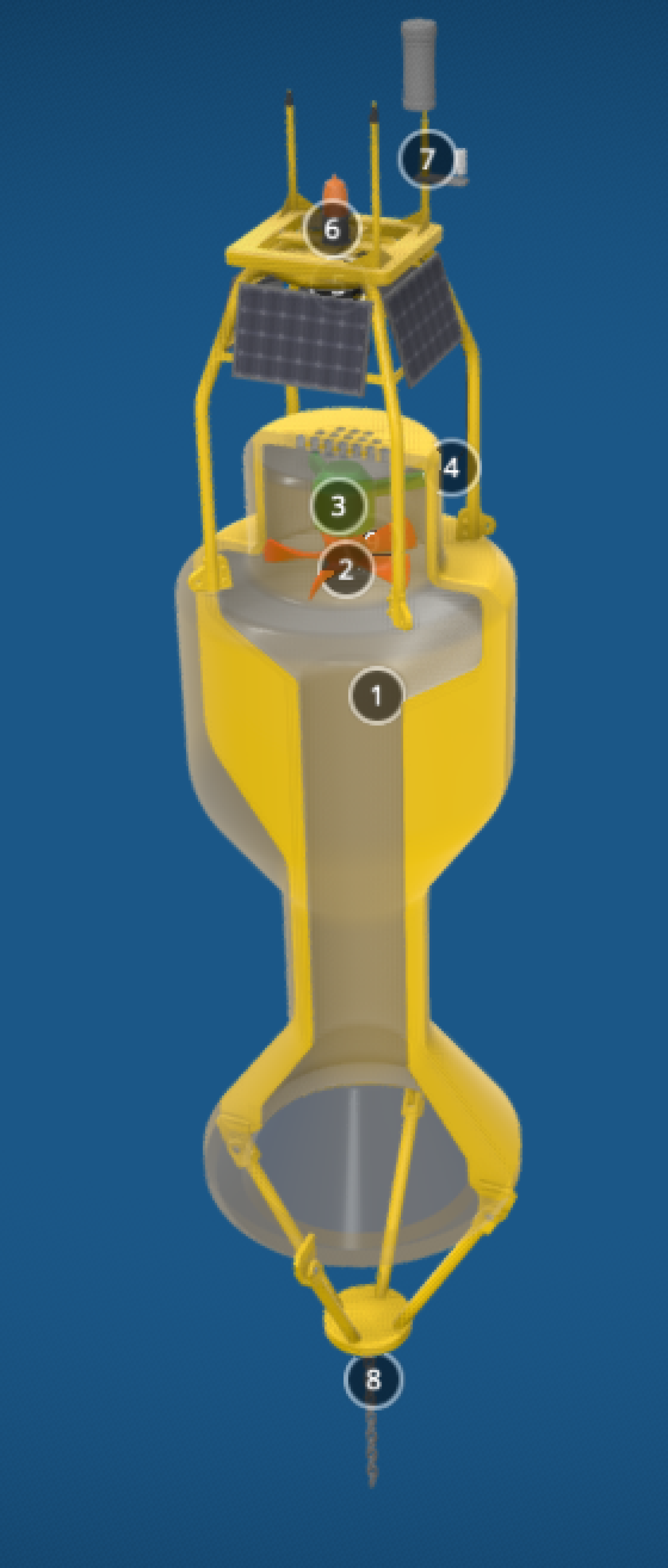
- Oscillating Water Column: The air and water interface that rises and falls with the buoy motion
- Turbine: Converts the oscillatory motion of the air in the chamber into rotational motion
- Generator: Converts the rotational motion of turbine blades into useful electrical power
- Electrical Cable: Allows the electricity from the generator to be sent to the navigation light
- Battery Module: Stores the energy produced by the generator to power various sensors on the buoy
- Navigation Light: Flashes on and off to make marine vessels aware of navigation hazards
- Communication Antenna: Allows for the buoy to send a warning signal to vessels
- Mooring Line: Connects the buoy to the seafloor to prevent the buoy from drifting away
- Float: Syntactic foam houses WEC and electronics package and allows mooring to float
Learn More
A vital aid to maritime navigation, navigation buoys guide ships safely through channels by marking potential hazards. These buoys ensure the safety of vessels and the people on them and facilitate efficient and secure maritime transportation.
Additional Resources
- Generating Actionable Intelligence From the Sea by OPT
- National Data Buoy Center Database
- Know Your Buoys: Navigating at Night
Relative Buoy Size
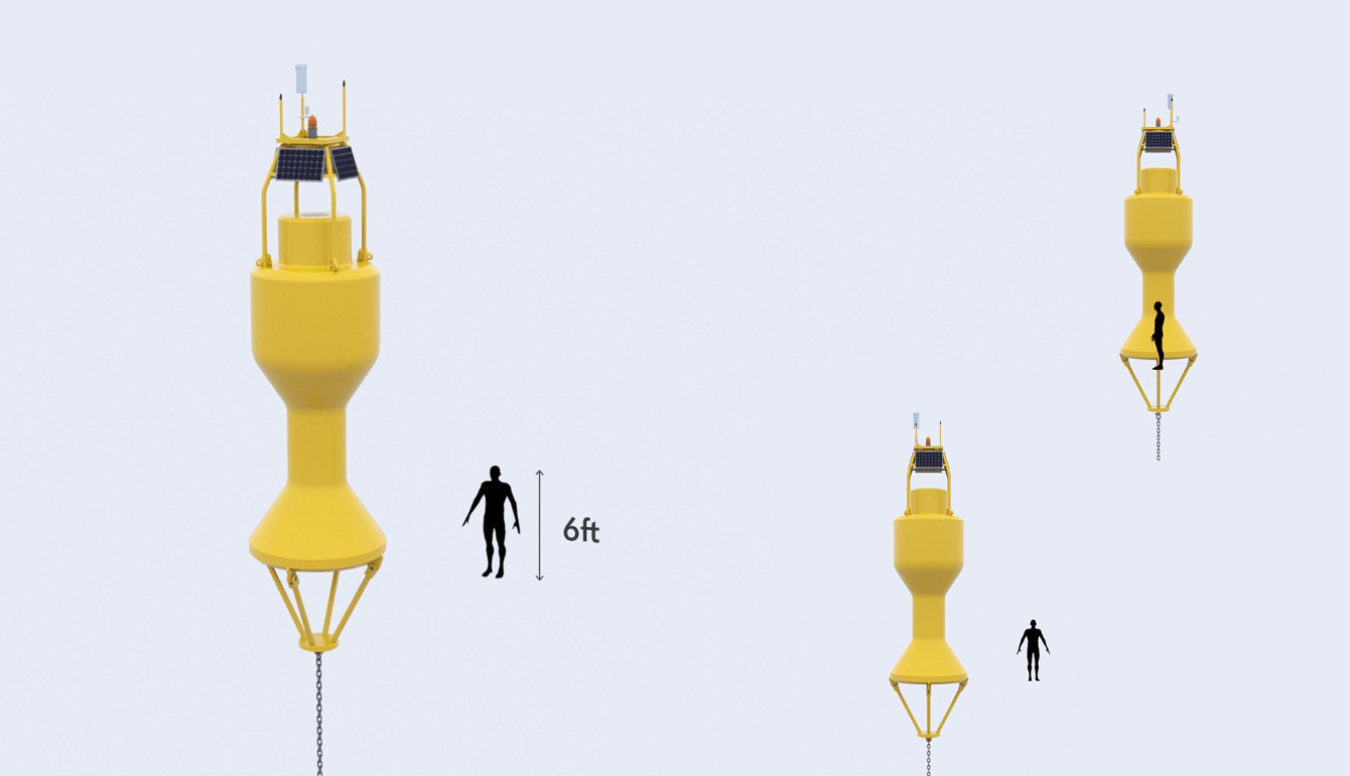
An image showing the size of a navigation buoy in comparison to a 6-foot-tall person.
Mooring System
See how mooring systems anchor devices like turbines or platforms in the ocean, securing them against currents and waves for efficient energy extraction.
Learn More
Ocean energy mooring systems anchor and stabilize devices such as wave energy converters in the dynamic marine environment. Three main types of mooring systems are commonly used:
Single-point mooring systems use a single anchor point on the seabed, allowing the energy conversion device to rotate and align itself with incoming waves or currents.
Multi-point mooring systems use several anchors placed around a device, making it more stable and controllable.
Dynamic positioning systems use thrusters or propellers to actively control the device's position, compensating for external forces and maintaining stability without traditional anchors.
Each mooring system has advantages and limitations that influence its suitability for different ocean energy technologies and site conditions. Factors such as water depth, wave and current characteristics, and the specific requirements of the energy conversion device play key roles in selecting the appropriate mooring system.
Additional Resources
Desalination Station
Desalination Facility
Explore REDi Island's model of a system that can produce clean drinking water using energy generated from ocean waves.
Watch the Desalination Station video.
Explore a 3D model of the desalination facility:

- Energy Recovery: An energy recovery system boosts pumping pressure by recycling energy from the brine.
- Reverse Osmosis: A semipermeable membrane that is used to separate salt from the seawater.
- Cleaning Treatment: After a final cleaning stage, the desalinated water is stored for future distribution.
Learn More
As communities around the world deal with changing water availability, they will need creative solutions to turn nontraditional water supplies like salt water or wastewater into drinking water.
Additional Resources
- Clean Water From Ocean Waves Animation by Mystic Aquarium
- SAROS Employees Talk About Turning Waves Into Fresh Water
- A HERO's Journey: NREL's Wave-Powered Desalination Device
Install Locations
Learn how to select the ideal location for a surge flap installation.
Learn More
Choosing the right location for a wave energy project is crucial to the success of the project. When designing a wave energy converter, it is important to consider the conditions at the project site. An ideal site would have good wave energy intensity and proximity to end users. But lots of other factors need to be considered when identifying an ideal installation location, such as:
- Water depth
- Regulations
- Marine protected areas
- Endangered species presence
- Data-cable routes
- Weather conditions
- Presence of sediment/debris
- Sea floor type (rock, sand)
- Competing uses for ocean space (fishing, surfing, vessel traffic)
- Local/political support
- Subsidies or other incentives from national and state governments that facilitate the adoption of wave/tidal energy.
NREL has developed the Marine Energy Atlas, an interactive mapping tool that explores the potential for marine energy resources in the United States.
Additional Resources
Surge Flap Technology
Find out why oscillating surge flaps installed on the seabed are one of the simplest ways to capture wave energy.
Explore a 3D model of a surge flap:
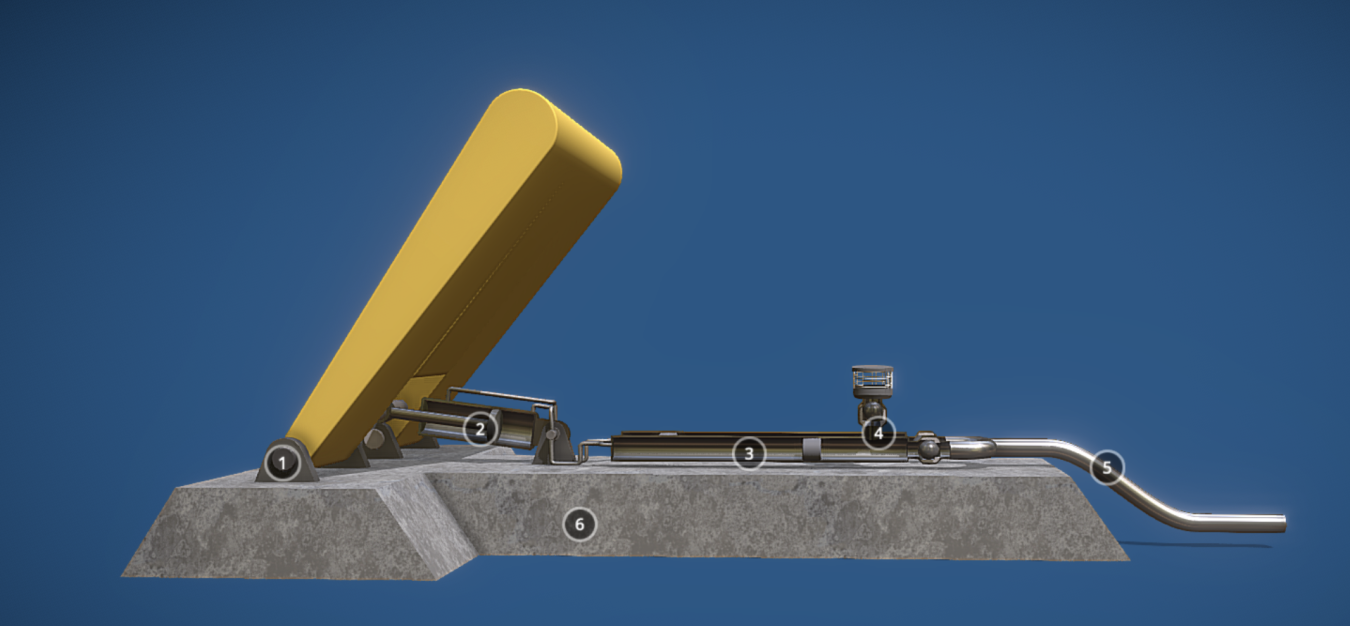
- Surge Flap Pivot Pin: Allows back-and-forth articulation of the surge flap.
- Hydraulic Cylinder: Generates pressurized fluid from the surge flap’s back-and-forth motion.
- Reciprocating Cylinders: Water is pumped by the piston’s action driven by the surge flap motion.
- Ball Valves: Prevents backflow into the cylinders.
- Outlet Pipe: Sends pressurized fluid down the pipe to the desalination system on shore.
- Gravity Anchors/Foundation: Anchors the system to the seafloor and resists the overturning moment from the wave action onto the flap.
Learn More
Surge flap devices are one of the simplest mechanisms used to capture wave energy. Due to their efficient design, they can play a key role in advancing renewable energy to address global energy needs.
Additional Resources
- A Window Into the Future of Wave Energy
- The Navy’s Surprising Energy Source That Could Power the World
- The Oyster Wave Power Technology by Aquamarine Power
Relative Device Size
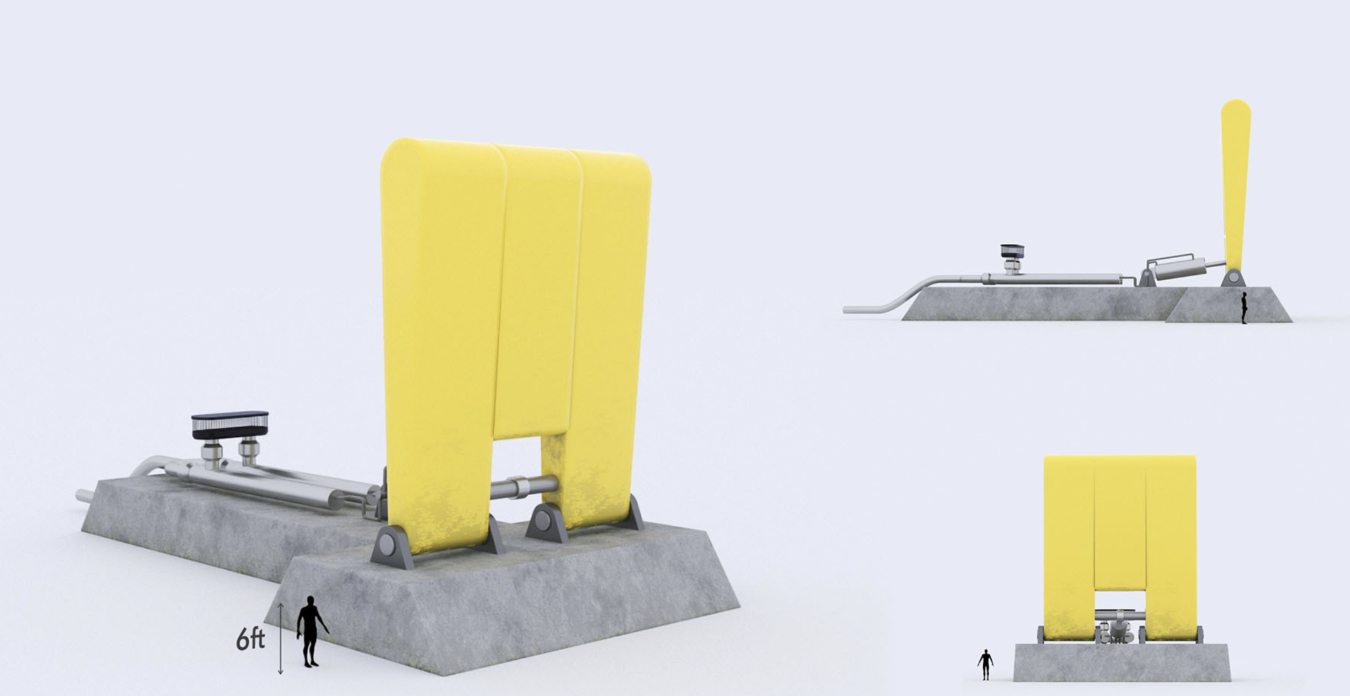
See how the size of a surge flap compares to a 6-foot-tall person.
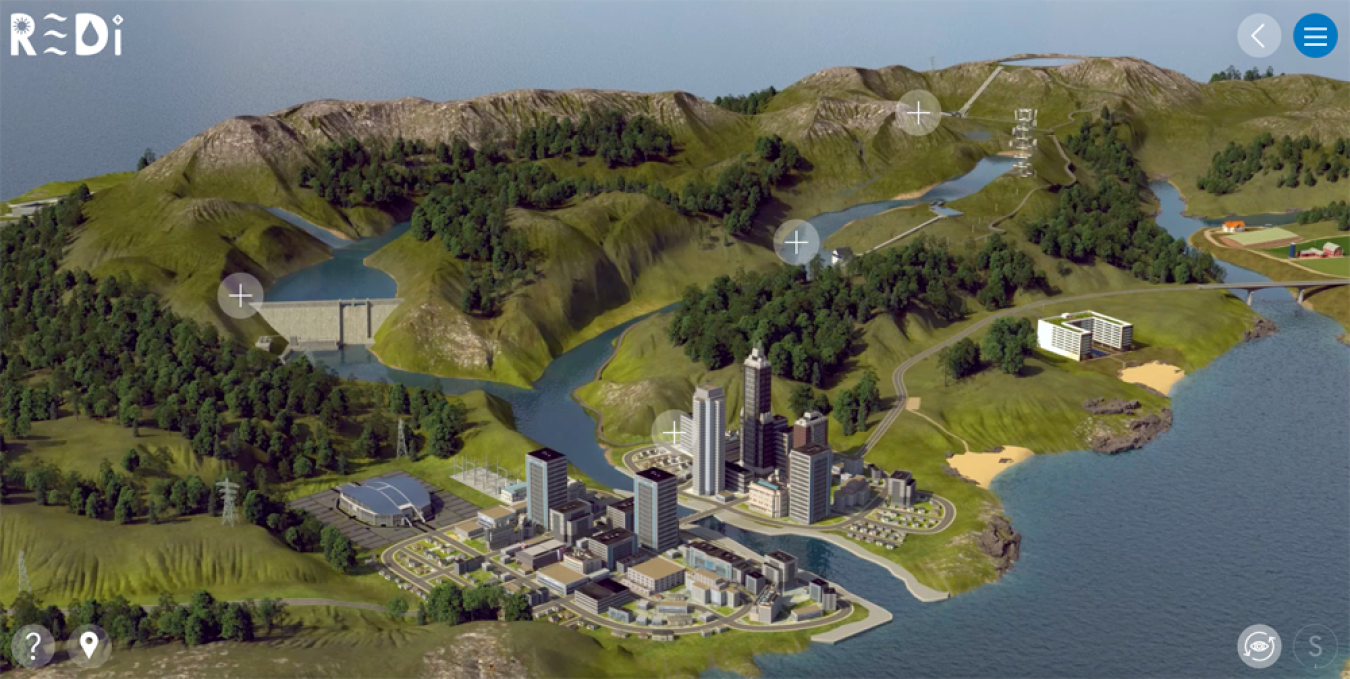
Hydro Hollow
Regulates water flow while producing electricity
Hydropower
Conventional hydropower uses dams to store water, releasing it to spin turbines and generate electricity.
Learn More
Conventional hydropower generates electricity using the energy of flowing water. Dams are built on rivers to create reservoirs, storing water. When released, the water flows through turbines, spinning them to produce electricity. This process converts the kinetic energy of moving water into mechanical energy, and then into electrical energy. Hydropower is renewable, as it relies on the water cycle.
Additional Resources
- Hoover Dam | Vegas PBS STEAM Camp
- Grand Coulee Dam And The Colville Indian Reservation
- Non-Powered Dams Offer Opportunity For Clean Energy
WATER MANAGEMENT
Hydropower plays a key role in water management by regulating river flow, preventing floods, providing water storage, and supporting irrigation.
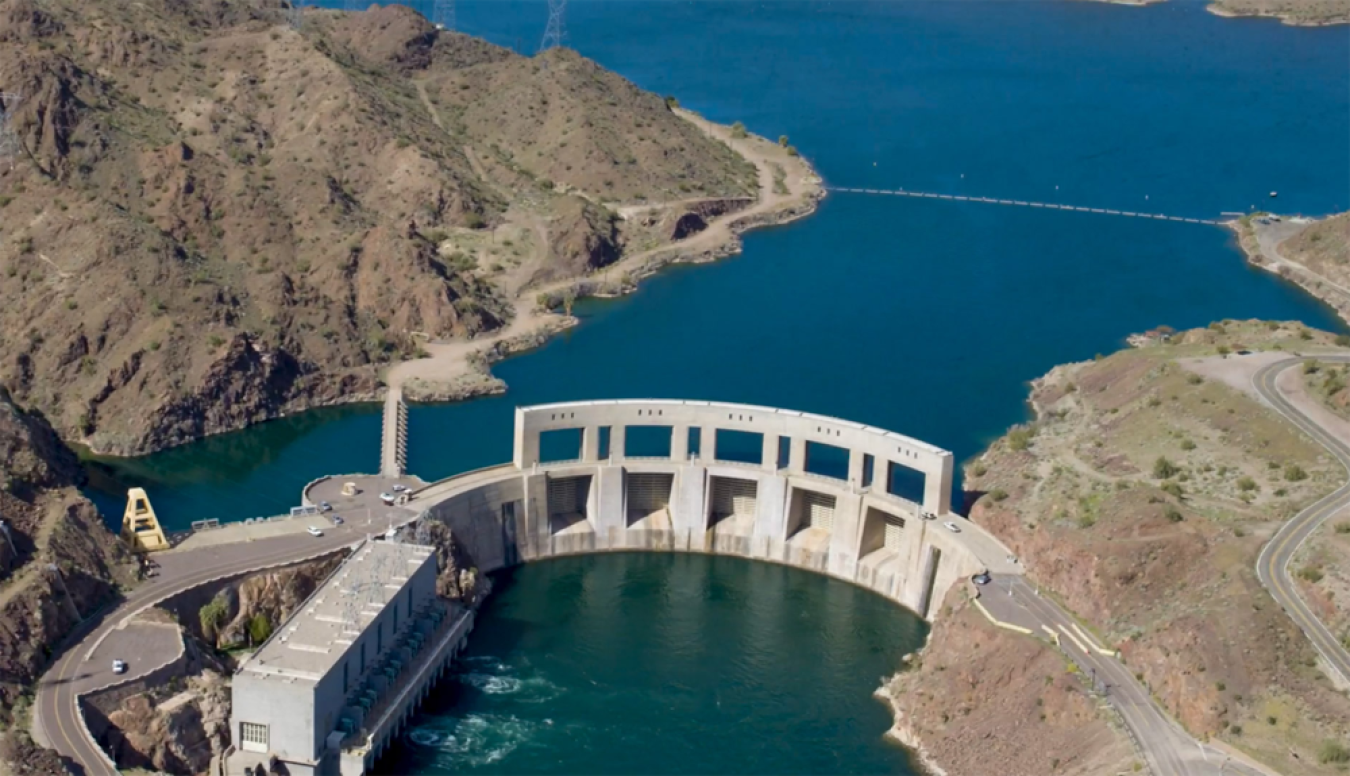
Learn More
Hydropower helps manage water systems by regulating river flows to prevent floods, store water, and support irrigation. It ensures a steady water supply for agriculture and communities. However, altered precipitation patterns and increased droughts can affect water availability. Changing river flows can reduce hydropower efficiency and reliability. Addressing these challenges requires adaptive management to balance energy production with water resources.
Additional Resources
- How Will Climate Change Impact Hydropower?
- How Dams Manage Water
- How a Hydropower Project Can Affect a River
WATER CYCLE
The water cycle is crucial for distributing fresh water, supporting life, regulating climate, and maintaining ecosystems on Earth.
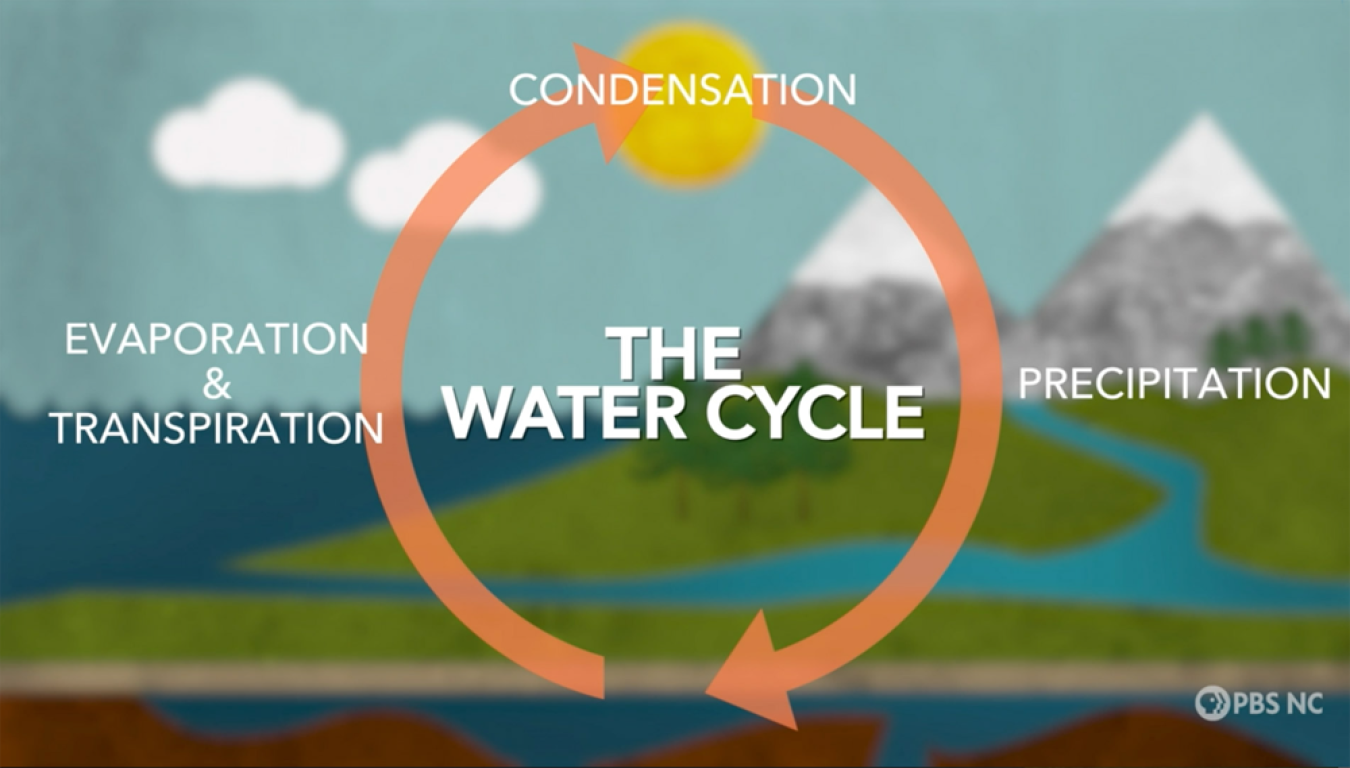
Learn More
Hydropower uses the water cycle to generate electricity. The sun heats water in rivers, lakes, and oceans, causing evaporation. Water vapor forms clouds and falls as rain or snow, replenishing rivers and reservoirs. Dams capture this flowing water, storing it in reservoirs. When released, the water flows through turbines, spinning them to generate electricity. This process converts the kinetic energy of moving water into mechanical energy, then into electrical energy, providing a renewable power source.
Additional Resources
- The REAL Water Cycle: The Water Cycle Revisited
- Matty the Water Molecule Game
- Humans and the Water Cycle
MODERNIZATION
Hydropower dam modernization improves efficiency, safety, and fish passage, reduces environmental impact and integrates smart technologies.
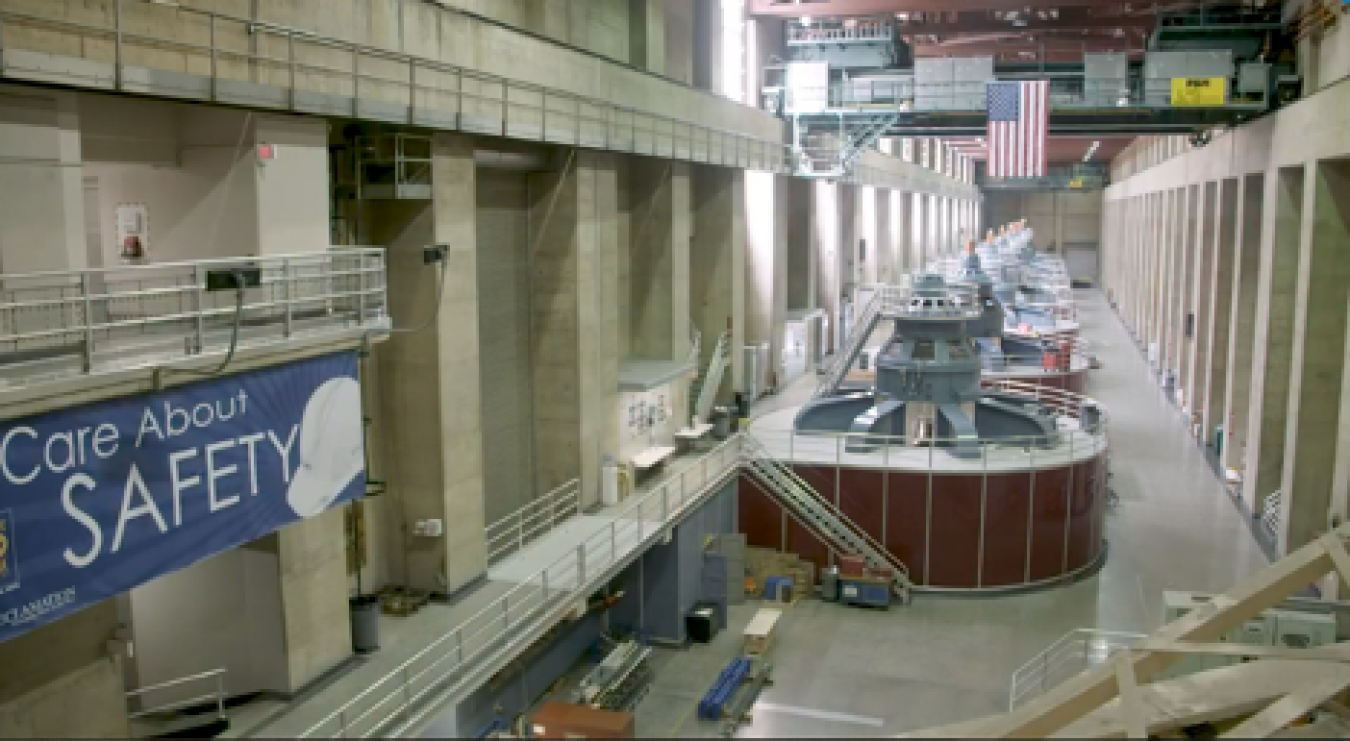
Learn More
Hydropower dam modernization efforts aim to enhance efficiency, safety, and environmental sustainability. Upgrades include installing advanced turbines to increase energy output, improving fish passage systems to protect aquatic life, and implementing smart technologies for better monitoring and management. These efforts are needed to ensure dams meet current environmental standards, reduce their ecological impact, and optimize their role in providing reliable, renewable energy amidst growing energy demands.
Additional Resources
- Cybersecurity and the Energy/Utilities Sectors
- Curious About Modernizing Hydropower Facilities? Explore These Six Questions
- OSU Researchers Look for Ways To Improve and Modernize Hydropower
FISH PASSAGE
Hydropower fish passage technology helps fish bypass dams safely, maintaining river ecosystems and fish populations.
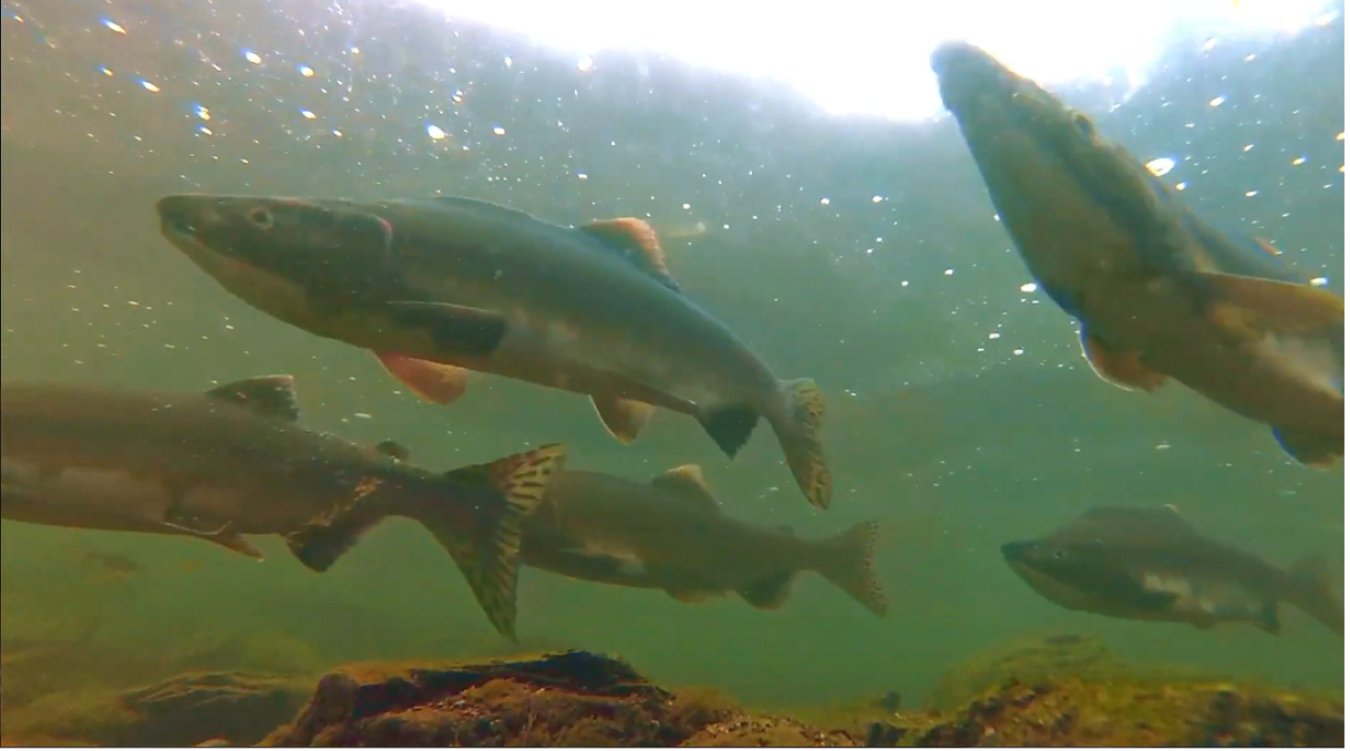
Learn More
Hydropower fish passage technology helps fish move around dams safely, ensuring they can reach spawning grounds. Methods include fish ladders, bypass channels, and fish lifts. Fish ladders are like watery staircases, bypass channels mimic natural streams, and fish lifts transport fish over dams. This technology is crucial because many fish species need to migrate to reproduce. By protecting fish populations, we maintain healthy ecosystems while still generating renewable energy from hydropower.
Additional Resources
- PNNL: What Is Fish Passage?
- Large Rainbow Trout Fish Passage Testing | PNNL Natel Study
- Salmon Summit | Careers in Fish Passage
RELATIVE SIZE
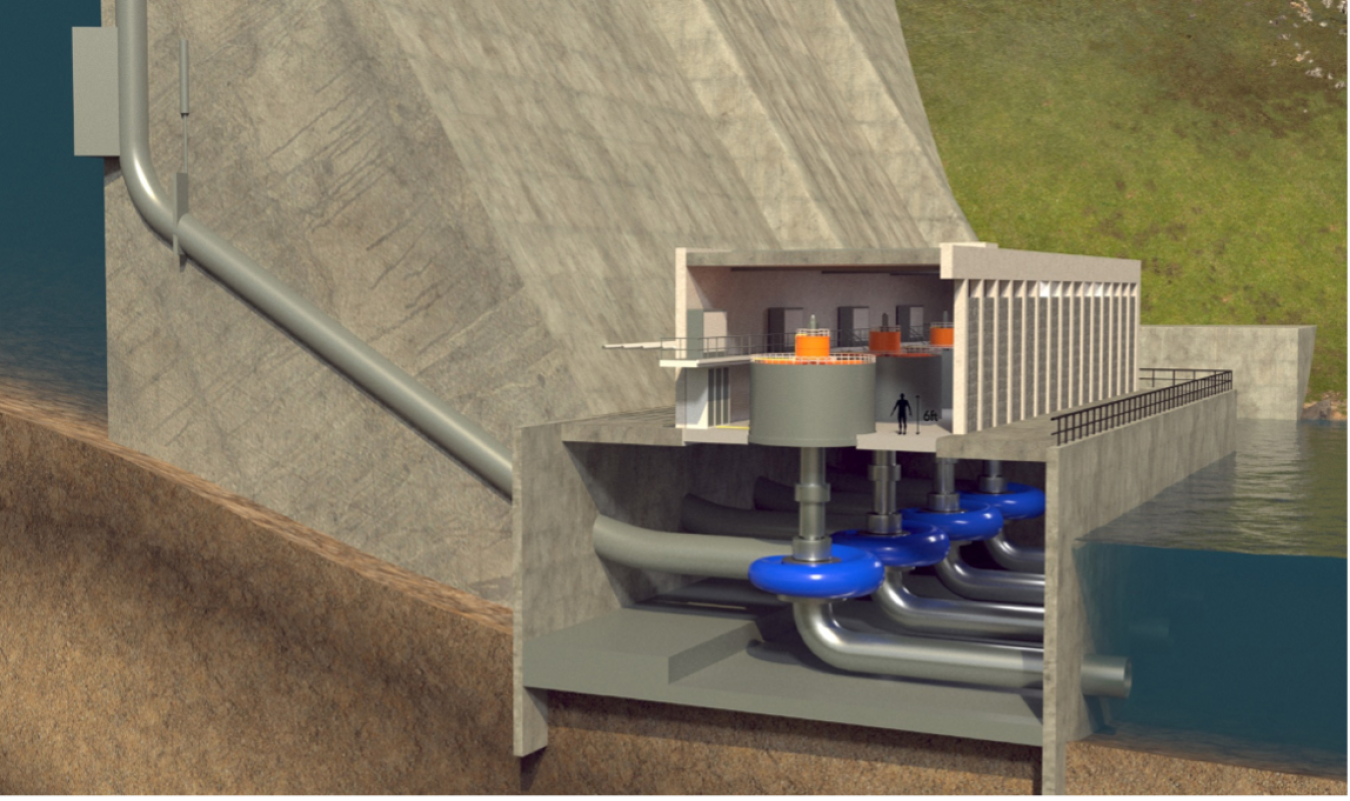
See how the size of a hydropower facility powerhouse compares to a 6-foot-tall person.
Hydro Heights
Stores energy like a battery for when it is needed
PUMPED STORAGE HYDRO
Energy can be stored and generated by moving water between two reservoirs.
Learn More
Pumped storage hydropower (PSH) is an innovative method of energy storage that balances electricity supply and demand to enhance grid stability. It involves two water reservoirs at different elevations. During low electricity demand, surplus energy pumps water from the lower to the upper reservoir. During high demand, stored water is released back to the lower reservoir, driving turbines to generate electricity. PSH is highly efficient, with rapid response times and large-scale storage capacity, making it essential for reliable power supply.
Additional Resources
- International Hydropower Association PSH Factsheet
- NREL Video: Why Is Pumped Storage Hydropower Important?
- Dominion Energy Protecting the Environment Around PSH Station
ISLAND VIEWPOINT
Get the lay of the land! View the island from a different perspective.
INSTALL LOCATIONS
Learn to identify ideal installation locations for a PSH facility.
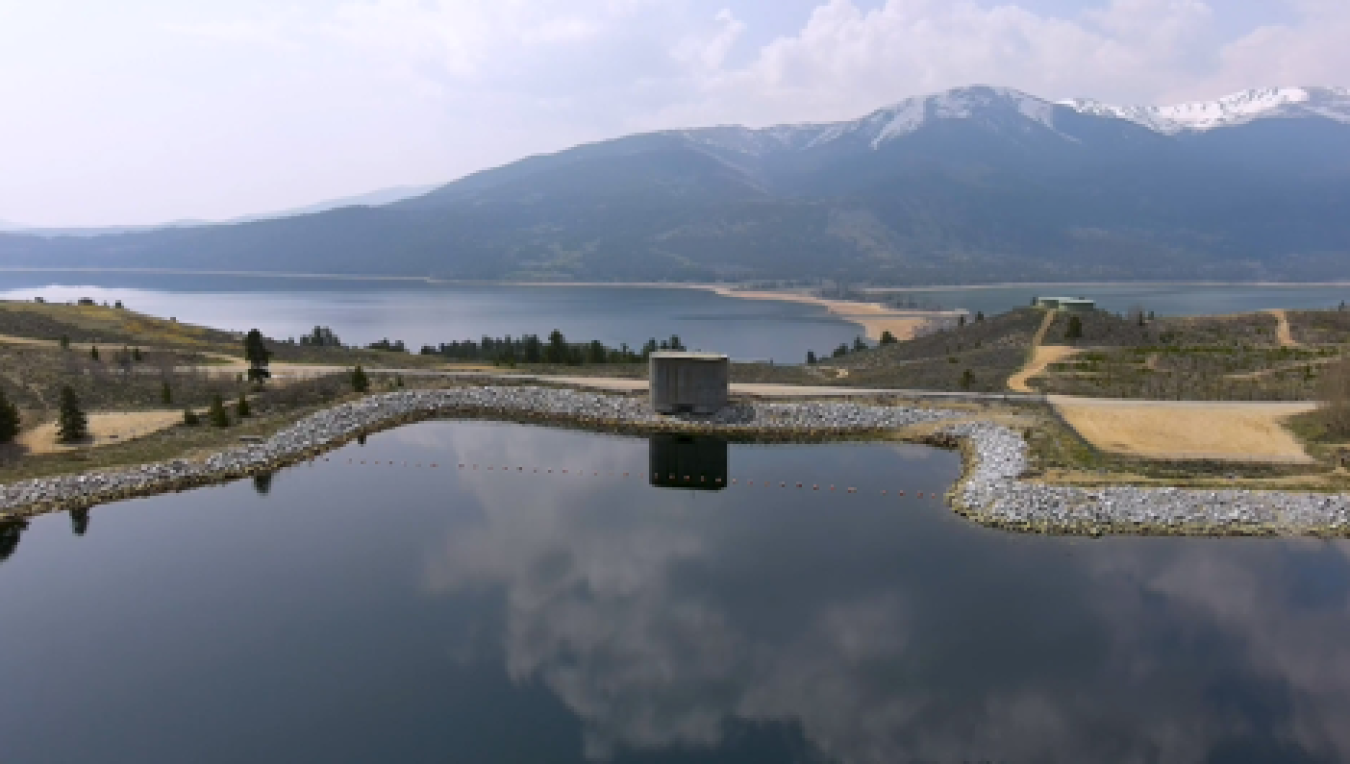
Learn More
The ideal location for PSH installations has specific geographic and environmental conditions. Key factors include elevation differences, water availability, proximity to the grid, land use compatibility, geological considerations, environmental impacts, and others. These criteria must be considered to ensure the optimal performance, cost-effectiveness, and environmental sustainability of PSH projects.
Additional Resources
- Geology and Geotechnical Issues for PSH Projects
- Navigating the Pumped-Storage Development Life Cycle - NHA
- Here's How Chimney Hollow Reservoir Will Be Filled Once It's Built
ENERGY STORAGE
Storing energy using bodies of water can help stabilize grids and manage peak demand.
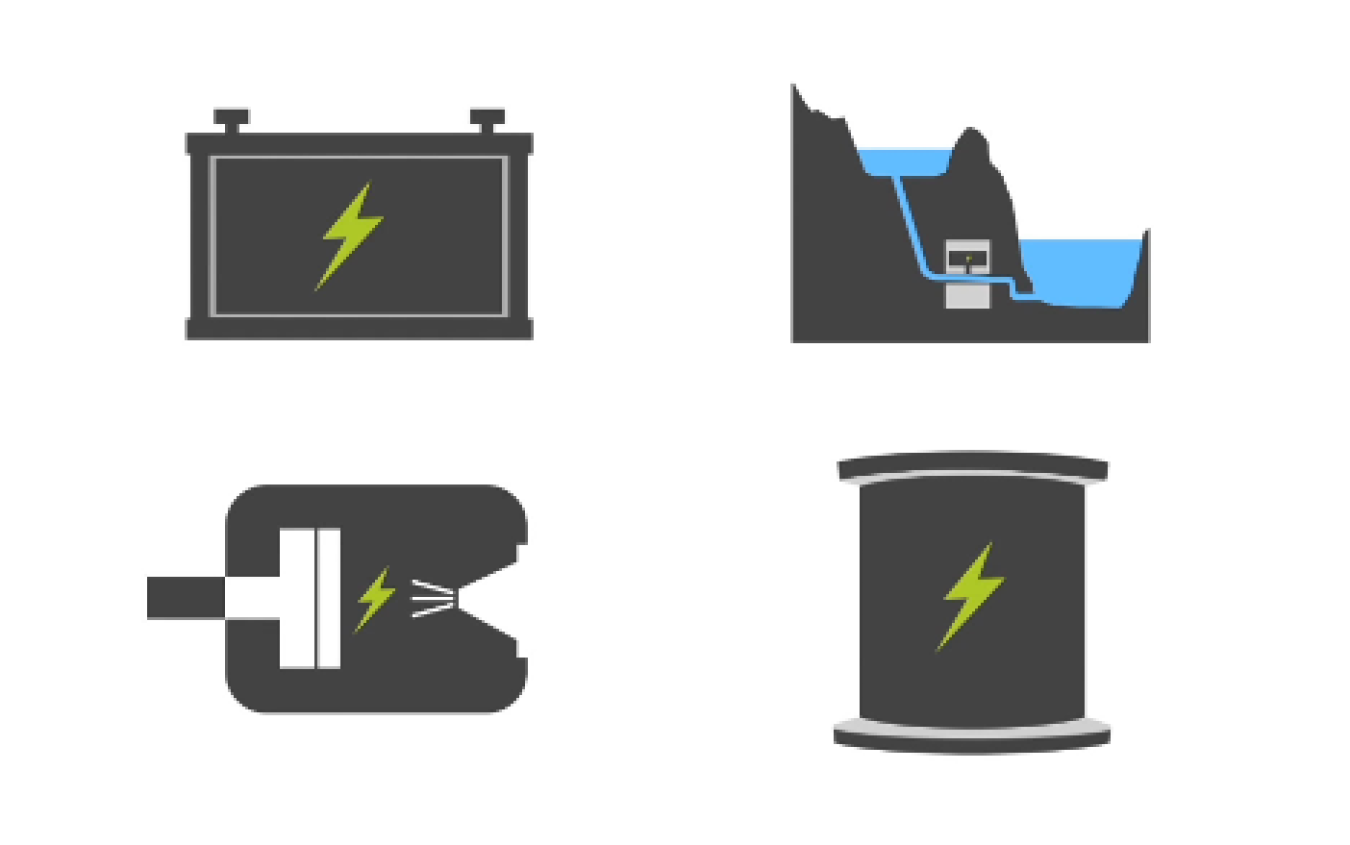
Learn More
Energy storage involves capturing energy as it's produced and storing it for use at a later time through methods like battery storage and PSH.
In PSH systems, during periods of low electricity demand, surplus energy is used to pump water from a lower reservoir to a higher one. This stored potential energy is then converted back to electricity during peak demand by releasing water from the higher reservoir, which flows through turbines to generate power. Energy storage helps balance the grid and manage fluctuations in demand.
Additional Resources
- Energy Storage 101
- Modo Energy - Battery Energy Storage: How Does It Work?
- World’s Largest Hydro-Floating Solar Farm Goes Live in Thailand
POTENTIAL ENERGY
What is potential energy and why is it relevant to water power generation?
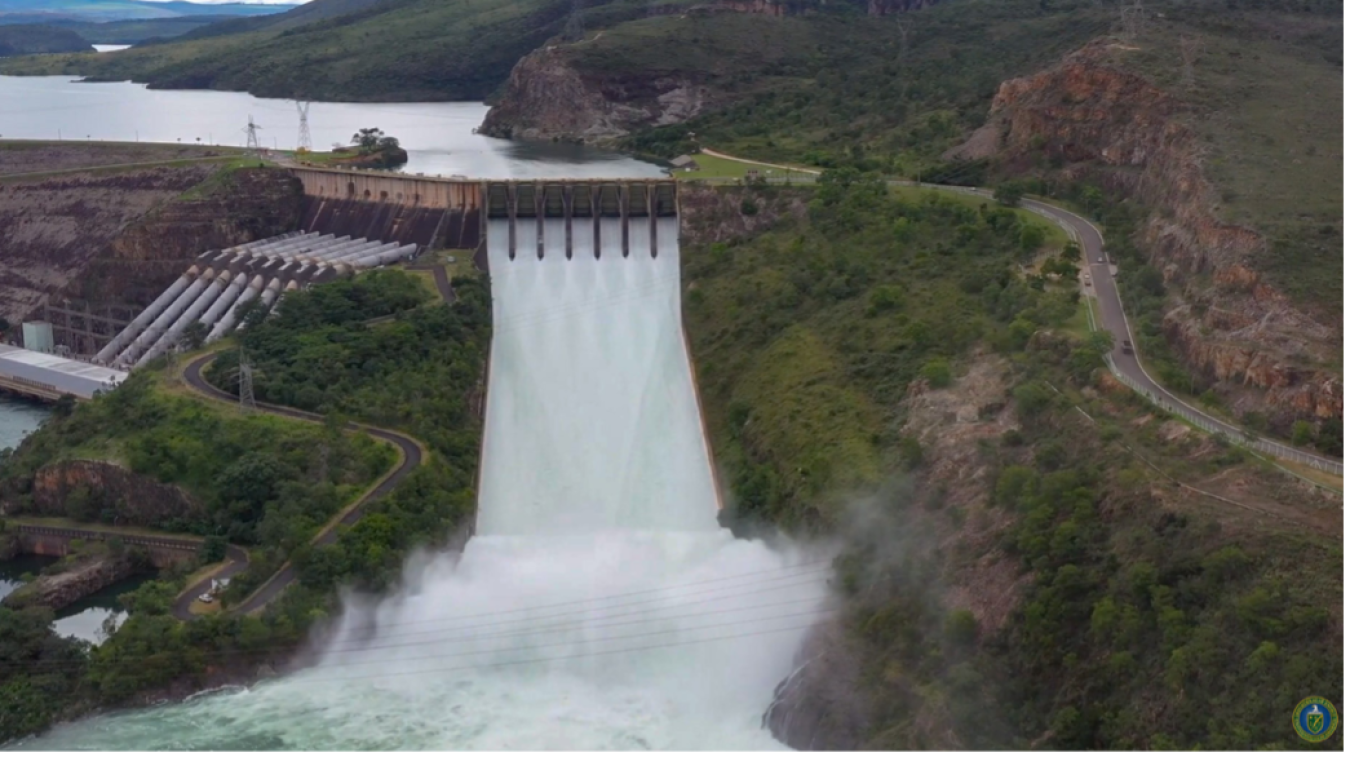
Learn More
Potential energy is stored energy, or energy held due to its position or state.
Water, when positioned at a height relative to a lower point, embodies gravitational potential energy. This energy can be harnessed through water power systems like PSH. PSH utilizes the stored potential energy of water in elevated reservoirs, pumping water uphill during periods of low demand and releasing it downhill to generate electricity when demand is high.
Additional Resources
- Nikola Tesla Harnessed the Power of Niagara Falls
- Potential Energy vs. Kinetic Energy
- University of Calgary: Energy from Water
RELATIVE SIZE
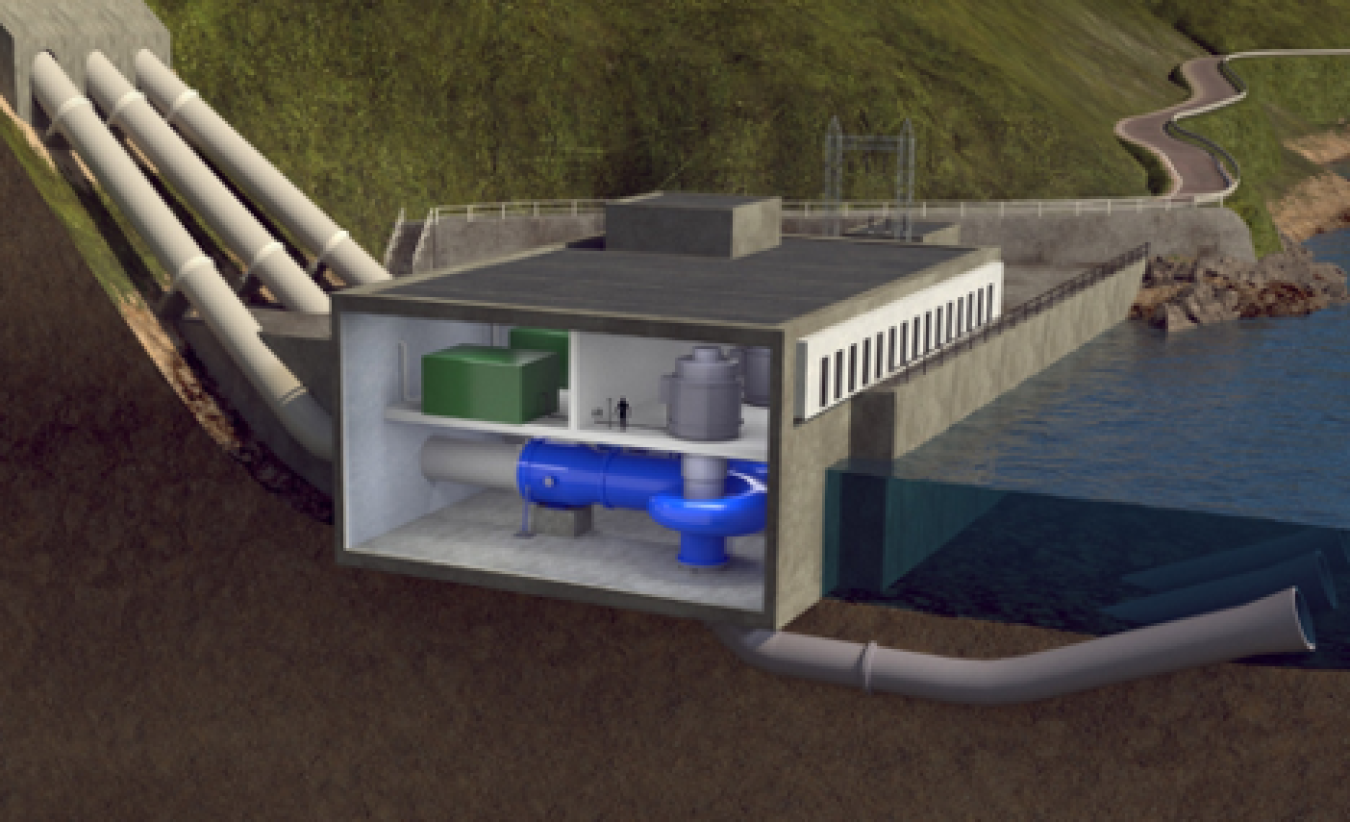
See how the size of a PSH turbine station compares to a 6-foot-tall person.
River Ramble
Channels a river's force to power a microgrid
RUN-OF-RIVER BYPASS
Run-of-river bypass technology produces energy with while reducing environmental impact, needing only constant flowing water and an elevation drop.
Learn More
Run-of-river bypass technology is a method of generating hydroelectric power by diverting a portion of a river's flow through a channel or pipe to drive turbines. Unlike traditional hydroelectric dams, this approach does not require large reservoirs. It therefore has less environmental impact and lower construction costs.
Additional Resources
- How a Run-of-River Hydroelectric Power Station Works
- Run-Of-River Power in British Columbia: Why It Makes Sense
- Low-Impact Hydropower Institute
COMMUNICATIONS TOWER
Explore how comms towers provide essential connectivity, emergency communications, and access to vital services for island communities.
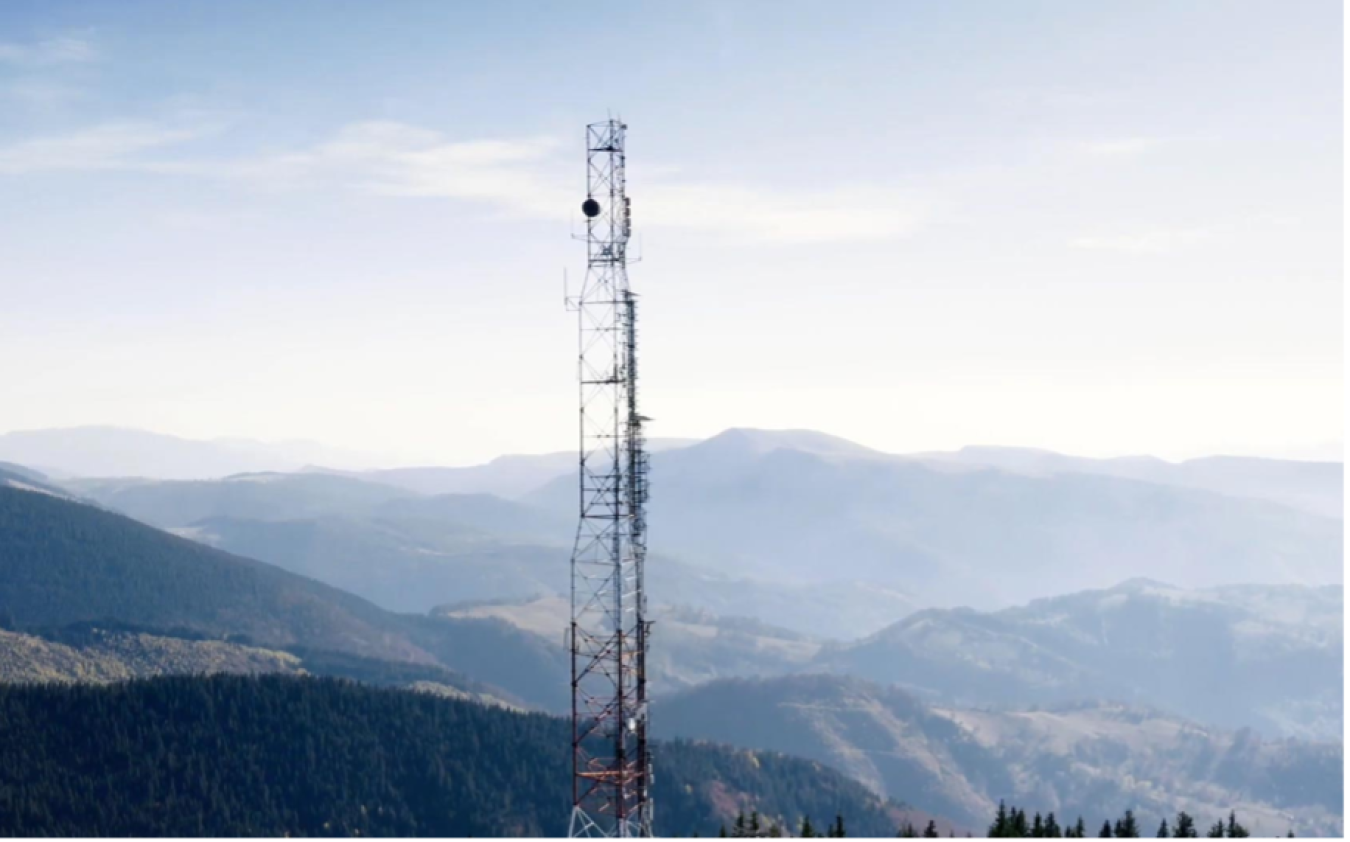
Learn More
Communications towers in island communities face challenges such as harsh weather conditions, corrosion from salt water, frequent maintenance needs, and vulnerability to natural disasters like hurricanes and typhoons. Also, island communications networks often struggle with limited bandwidth and connectivity issues because of their remote locations. Providing networks involves high costs, significant energy, limited infrastructure, and reliance on satellite links.
Additional Resources
- Avian-Friendly Lights: A Win-Win for Communications Towers
- Tribal Communities Face Challenges Accessing the Internet
- Drones Being Used To Restore Mobile Phone Communication in Remote Areas
MICROGRIDS
Microgrids are localized power systems that can operate independently or connect to the main grid to enhance reliability and resiliency.
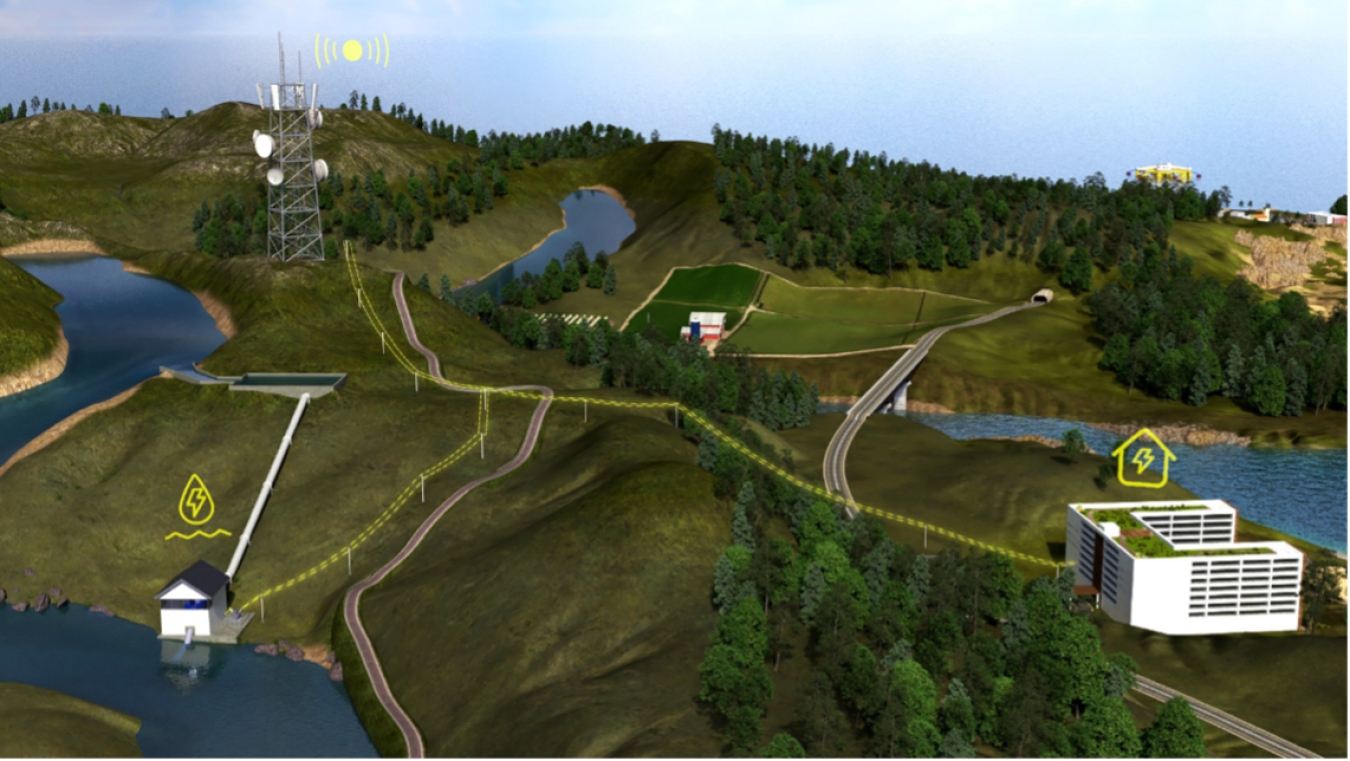
Learn More
Microgrids are decentralized energy systems that can operate independently or connect to the main grid. They enhance resiliency by delivering backup power during outages, and they provide redundancy by diversifying energy sources to improve reliability and ensure continuous electricity supply—which are crucial for critical facilities and remote areas.
Additional Resources
- Building Blocks of our Future Electricity Grid: Microgrids
- Improving Grid Resilience Using Small Hydro
- Understanding Why Microgrids are the Future
SMALL-SCALE HYDRO
Discover the impact of small-scale hydropower on communities, sustainable development, and local economies.
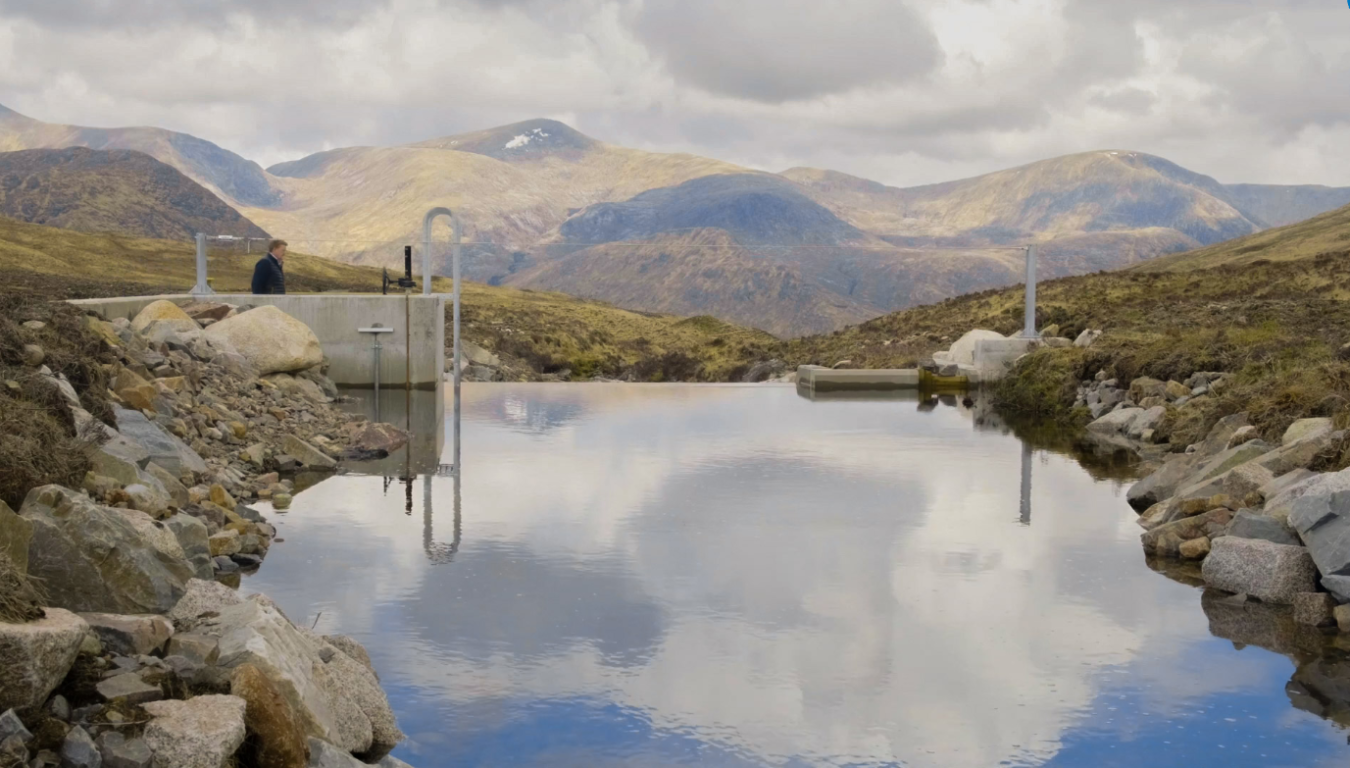
Learn More
Small-scale hydropower projects are crucial for remote communities—they offer energy while reducing reliance on the power grid, and they promote local economic development. Many small-scale hydro projects are owned by their communities. Community ownership ensures direct benefits, empowers locals, and creates resiliency and self-sufficiency.
Additional Resources
- Power to the People: An Overview of Community Energy
- Small-Scale Run-of-River Hydro in West Scotland
- Hillsboro In Conduit Hydroelectric Project Comes Online
RIVER POWER
Did you know that rivers carry tremendous kinetic energy that when harnessed can provide electricity?
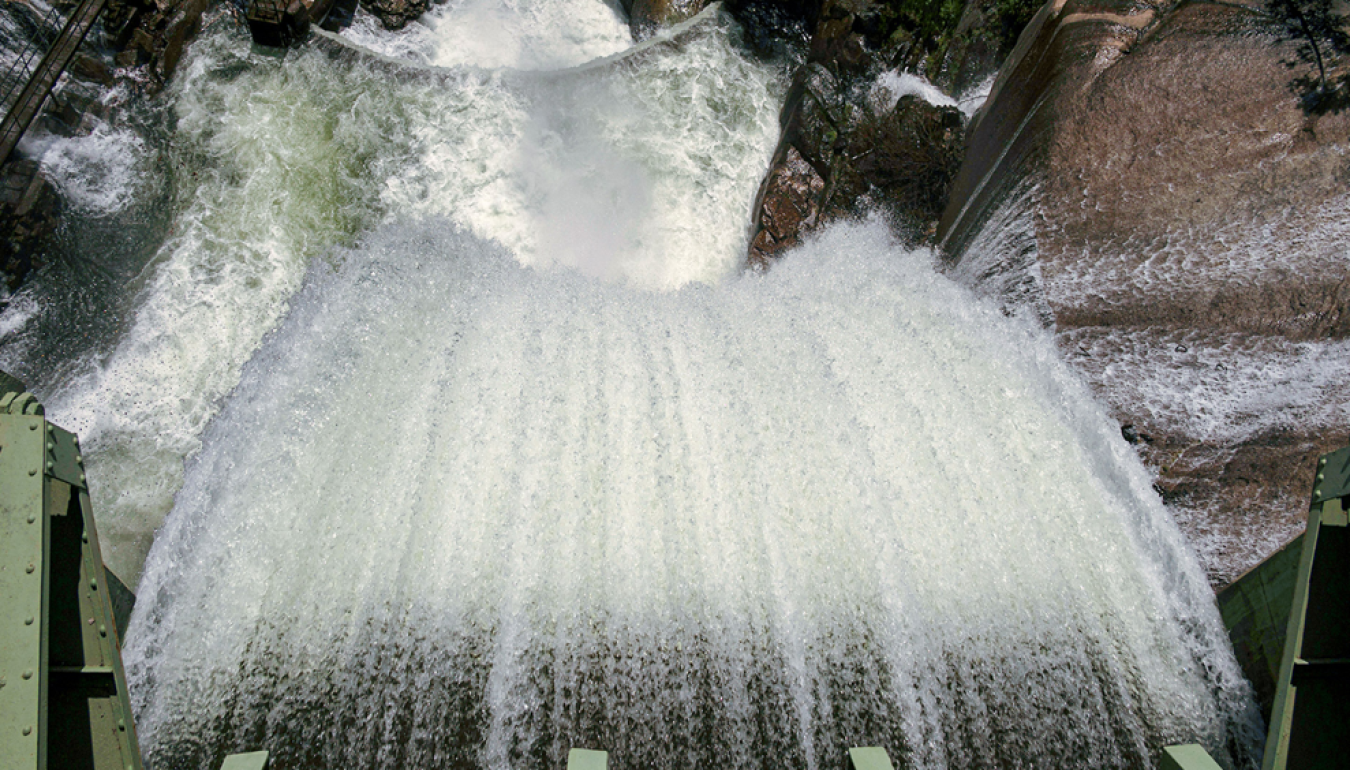
Learn More
Rivers possess vast untapped energy in their flowing water. This kinetic energy can be harnessed through various methods, including hydroelectric dams, run-of-river systems, and pumped storage hydropower.
Additional Resources
RELATIVE SIZE
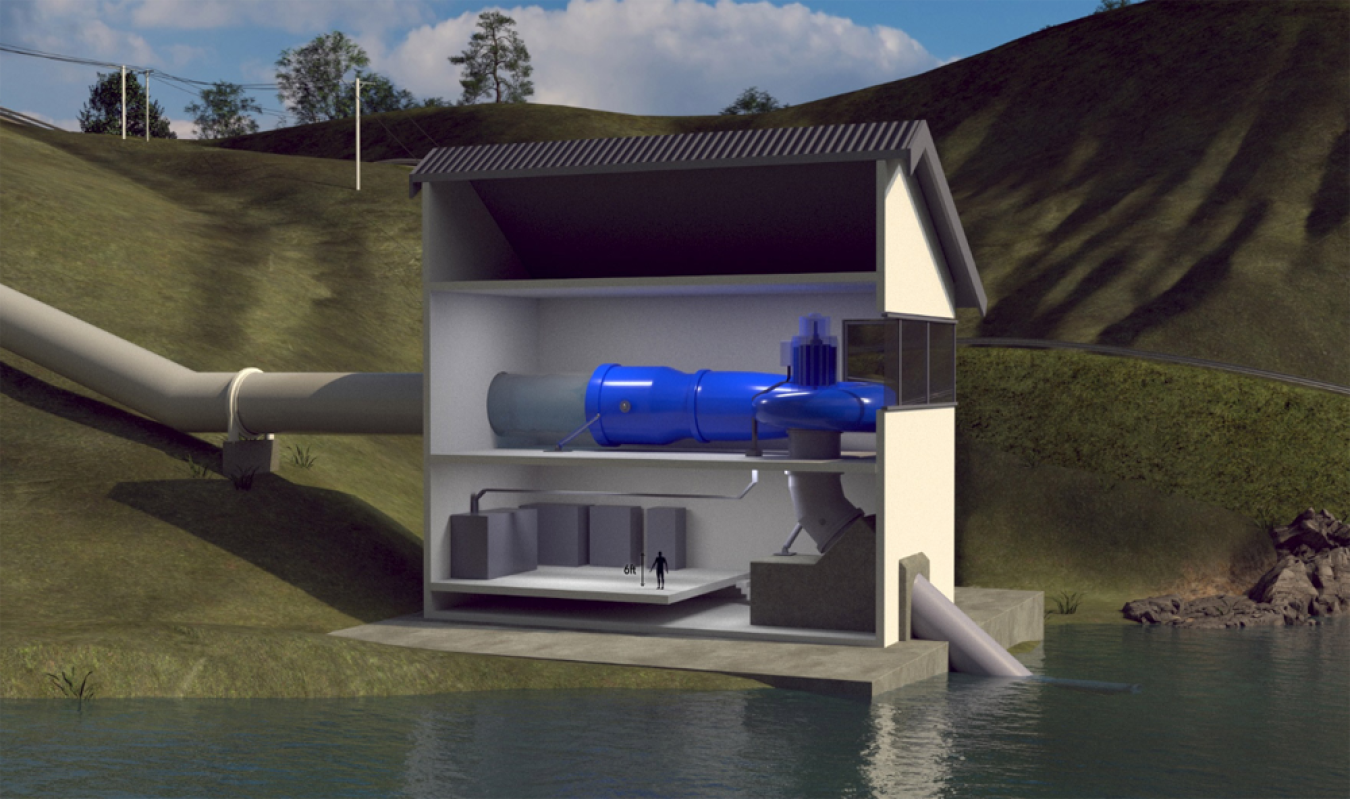
See how the size of a run-of-river bypass powerhouse compares to a 6-foot-tall person.
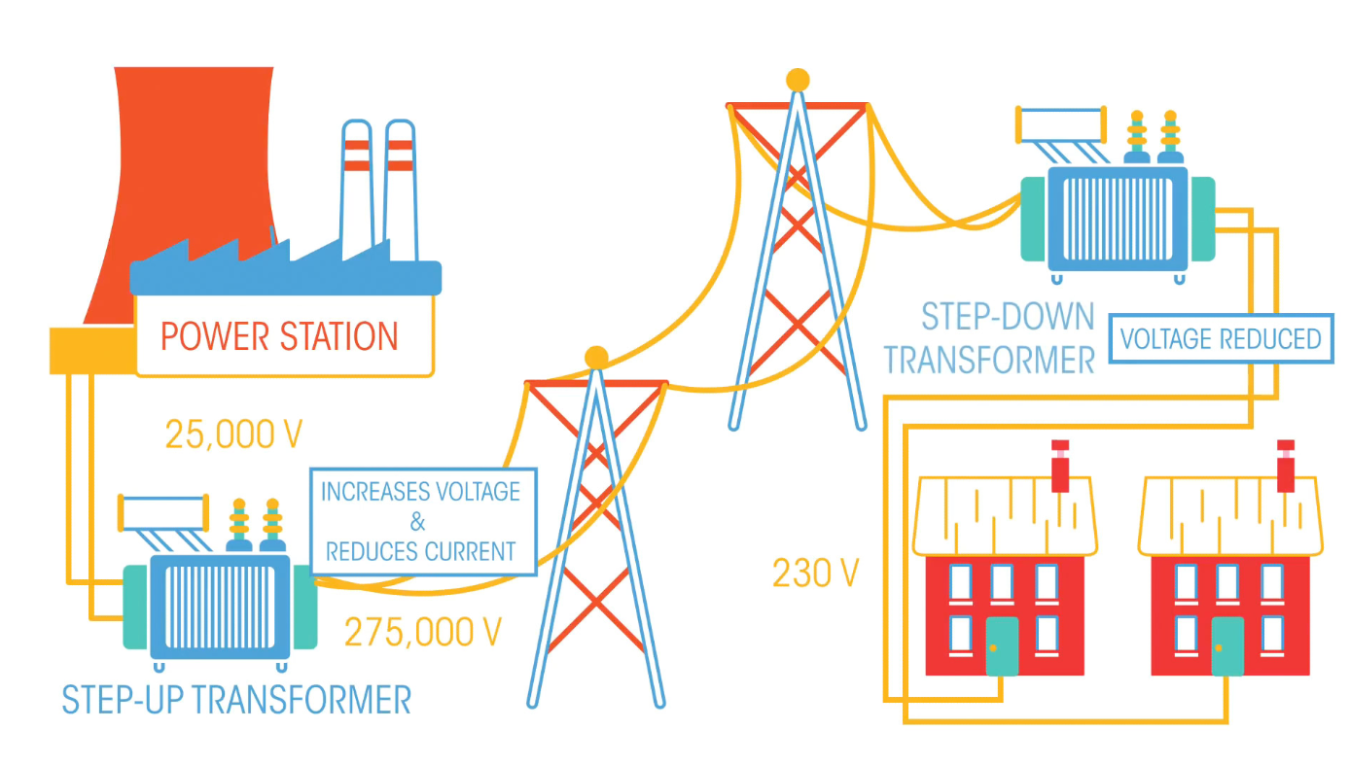
Learn More
The electric power grid is a vast network that delivers electricity from power plants to homes and businesses. It consists of power plants, transmission lines, substations, and distribution lines. Power plants generate electricity, which travels long distances via high-voltage transmission lines. Substations reduce the voltage, making it safe for local distribution lines to deliver electricity to homes and businesses. The grid ensures we have reliable access to electricity for lights, appliances, and technology essential to daily life.
Additional Resources
SCALABLE POWER
Cities ensure scalable power by investing in energy, smart technologies, and by upgrading grid infrastructure.
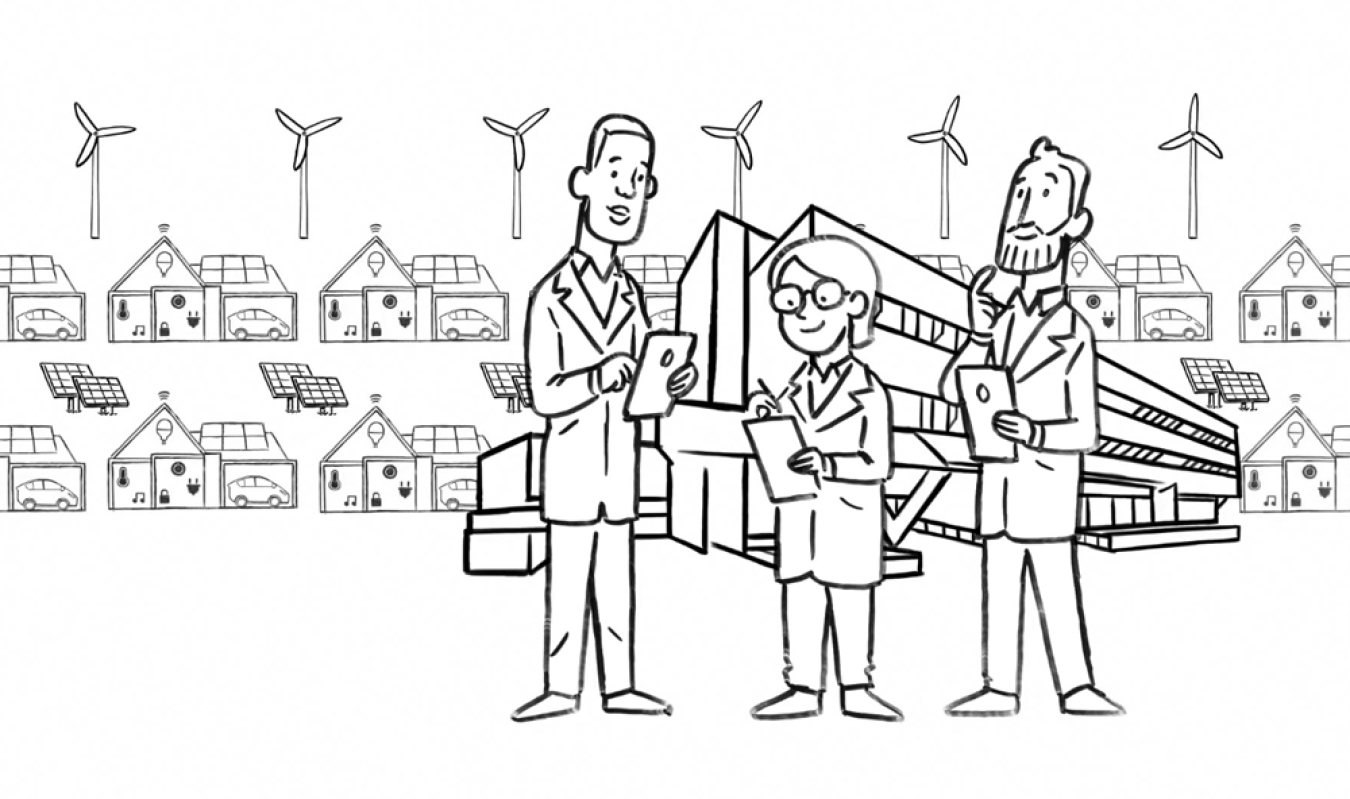
Learn More
Scalable power means the ability to increase or decrease power supply to meet demand. It's essential for handling population growth, economic development, and technological advancements. With scalable power, cities can provide reliable electricity and improve grid efficiency. This flexibility helps prevent blackouts, reduces costs, and supports development, ensuring that energy needs are met now and in the future.
Additional Resources
- An Energy Transition Made Easy
- Urbanization and the Evolution of Cities Across 10,000 Years
- Smart Cities: Embracing Technology for Sustainable Urban Living
ENERGY CONSUMPTION
Come see how energy is delivered to consumers through the grid.
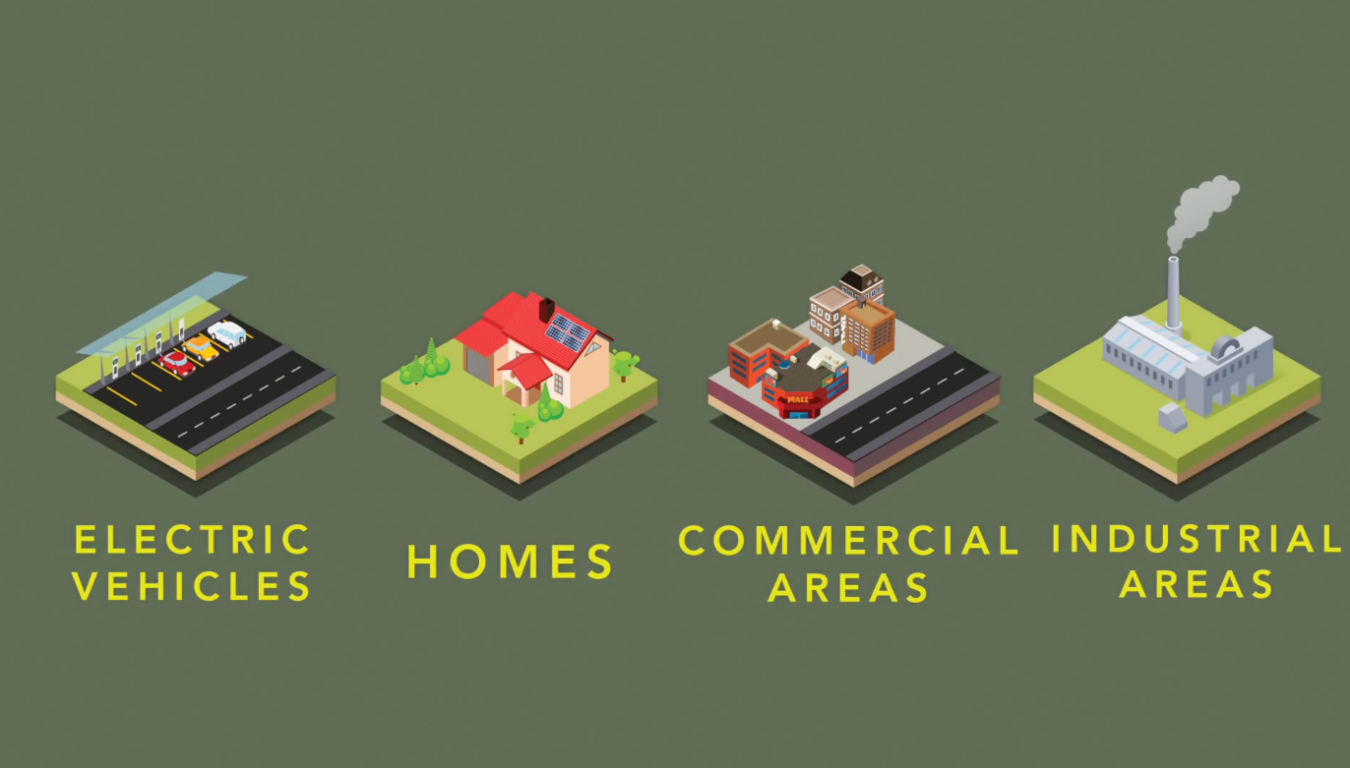
Learn More
Electricity delivered from the grid has multiple uses in residential and commercial buildings, such as lighting, heating, cooling, refrigeration, and appliance operation.
Total electricity consumption includes the sale of electricity and the direct use of electricity at the facility where it is produced.
Additional Resources
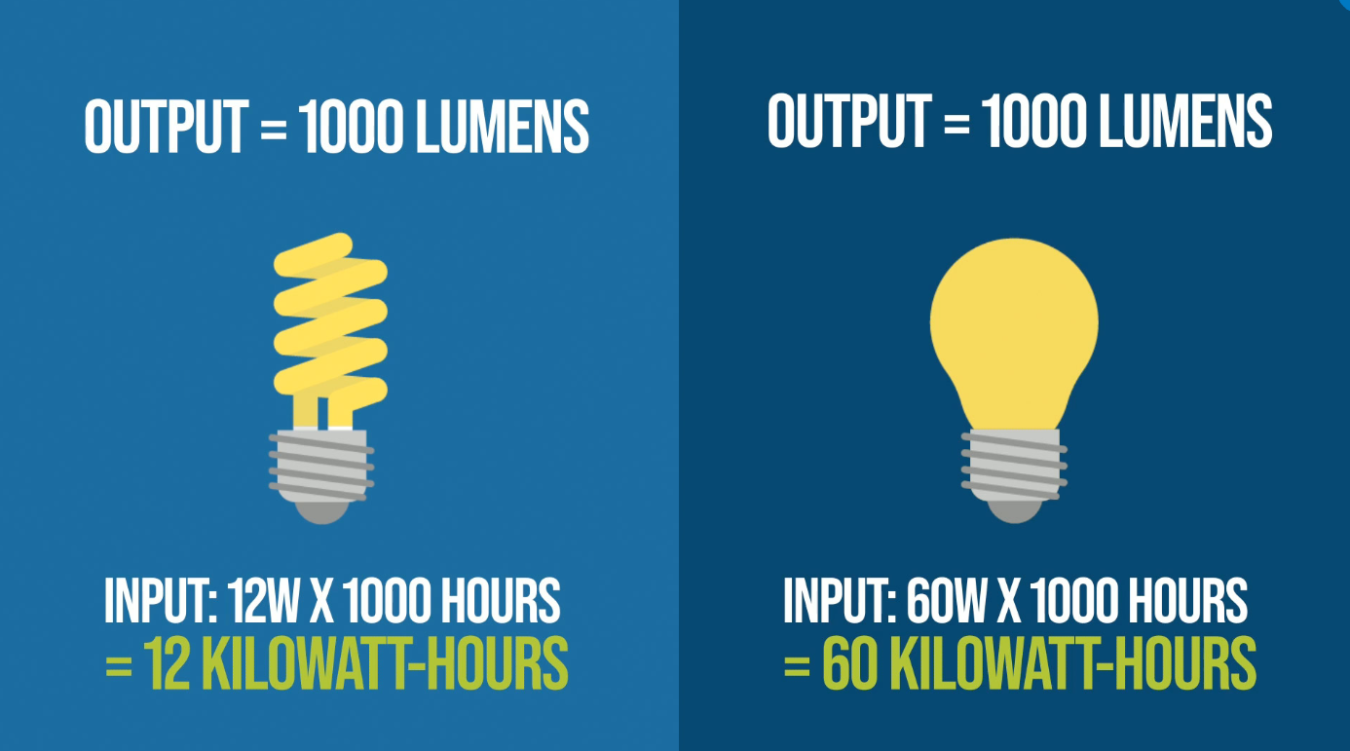
SUBSTATION
This substation transforms high-voltage electricity from power plants into lower voltages for homes and businesses.
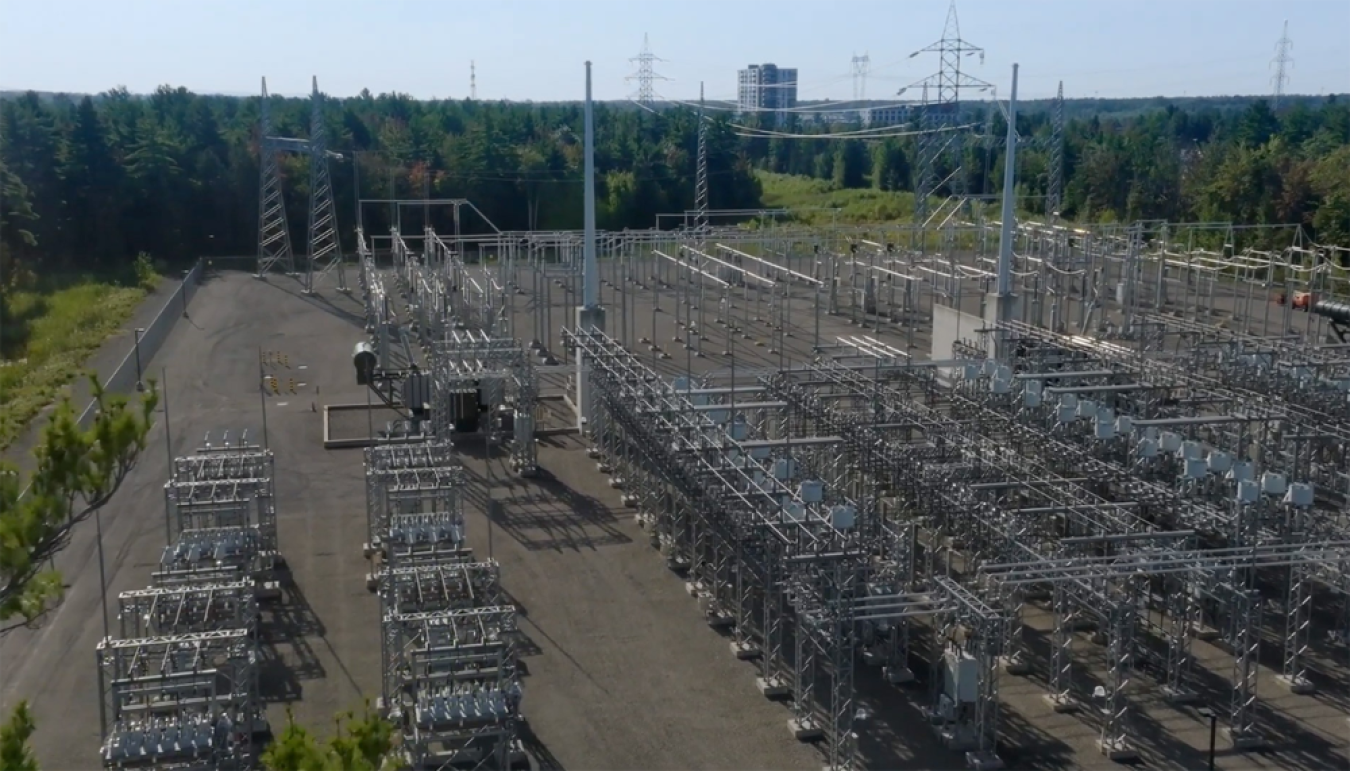
Learn More
Substations are crucial parts of the power grid, acting as hubs where high-voltage electricity from power plants is converted to lower voltages for safe distribution. They consist of transformers, circuit breakers, and other equipment. Without substations, the electricity generated would be too powerful for everyday use, causing damage to homes and businesses. Substations ensure electricity is efficiently and safely delivered, keeping lights on, appliances running, and the city powered up.
Additional Resources
About the Project
Learn more about Renewable Energy Discovery (REDi Island).
Curriculum Resources
Explore REDi Island activities created by educators for educators and designed to engage students in a dynamic learning experience. Each activity is carefully structured to cater to different learning styles for elementary through secondary students.
Providing a user-friendly interface and a multitude of educational resources at your fingertips, REDi Island's activities are structured to promote both individual exploration and guided learning.
These activities may support and add context to content that reinforces the Next-Generation Science Standards (NGSS) Science and Engineering Practices in addition to the following Disciplinary Core Ideas:
- PS2 - Motion and Stability: Forces and Interactions
- PS3 - Energy
- PS4 - Waves and Their Applications
- ESS3 - Earth and Human Activity
- ETS1 - Engineering and Design
Careers in Marine Energy Activity
The Careers in Marine Energy activity encourages students to explore the technologies featured around the island and create career profiles of the skills and backgrounds required to work with a specific marine energy technology.
Resources and materials:
Best for intermediate and secondary students. Elementary students can complete this activity with modifications and more precise instruction.
REDi Island Scavenger Hunt Activity
The REDi Island Scavenger Hunt activity guides students around REDi Island to look for points of interest, technology information, educational videos, and more!
Resources and materials:
Best for elementary, intermediate, and secondary students.
Credits
Funded by the U.S. Department of Energy (DOE) Office of Energy Efficiency and Renewable Energy's Water Power Technologies Office, the Renewable Energy Discovery (REDi) Island initiative was created by the DOE’s National Renewable Energy Laboratory and a team of three-dimensional visualization and software development specialists from IKM 3D.
A special thanks to our industry, academic, and government partners who provided essential feedback on the REDi Island app.

